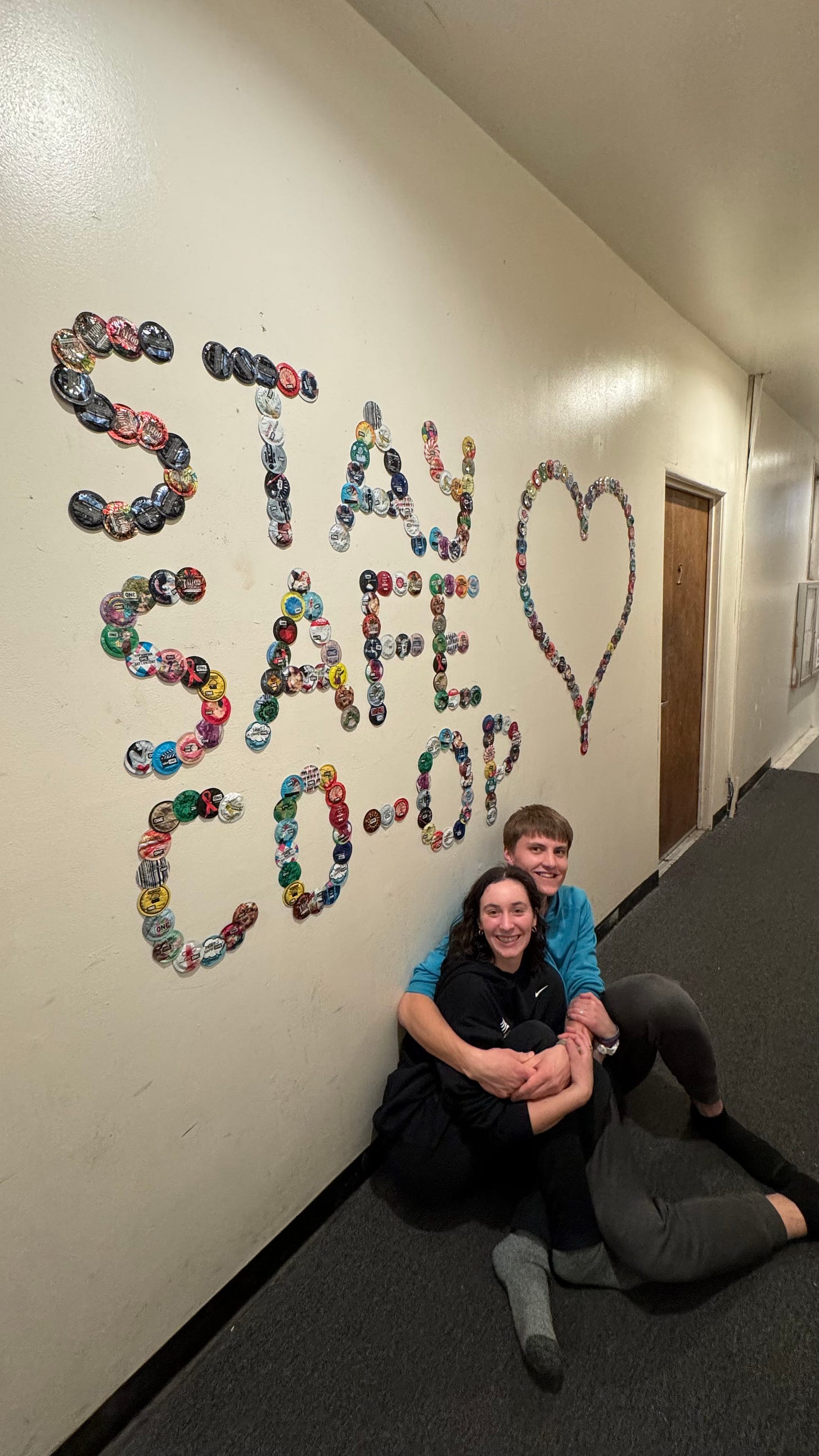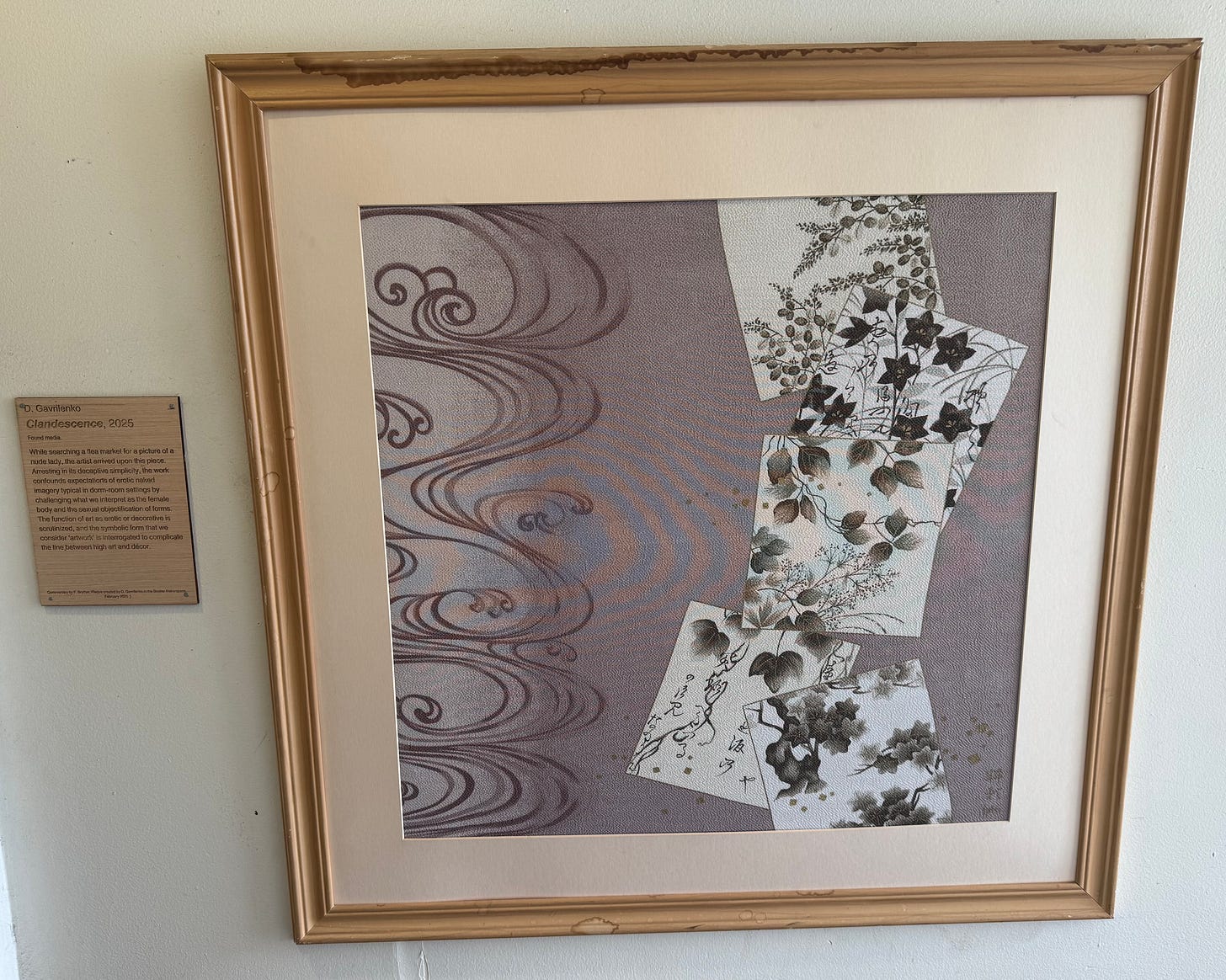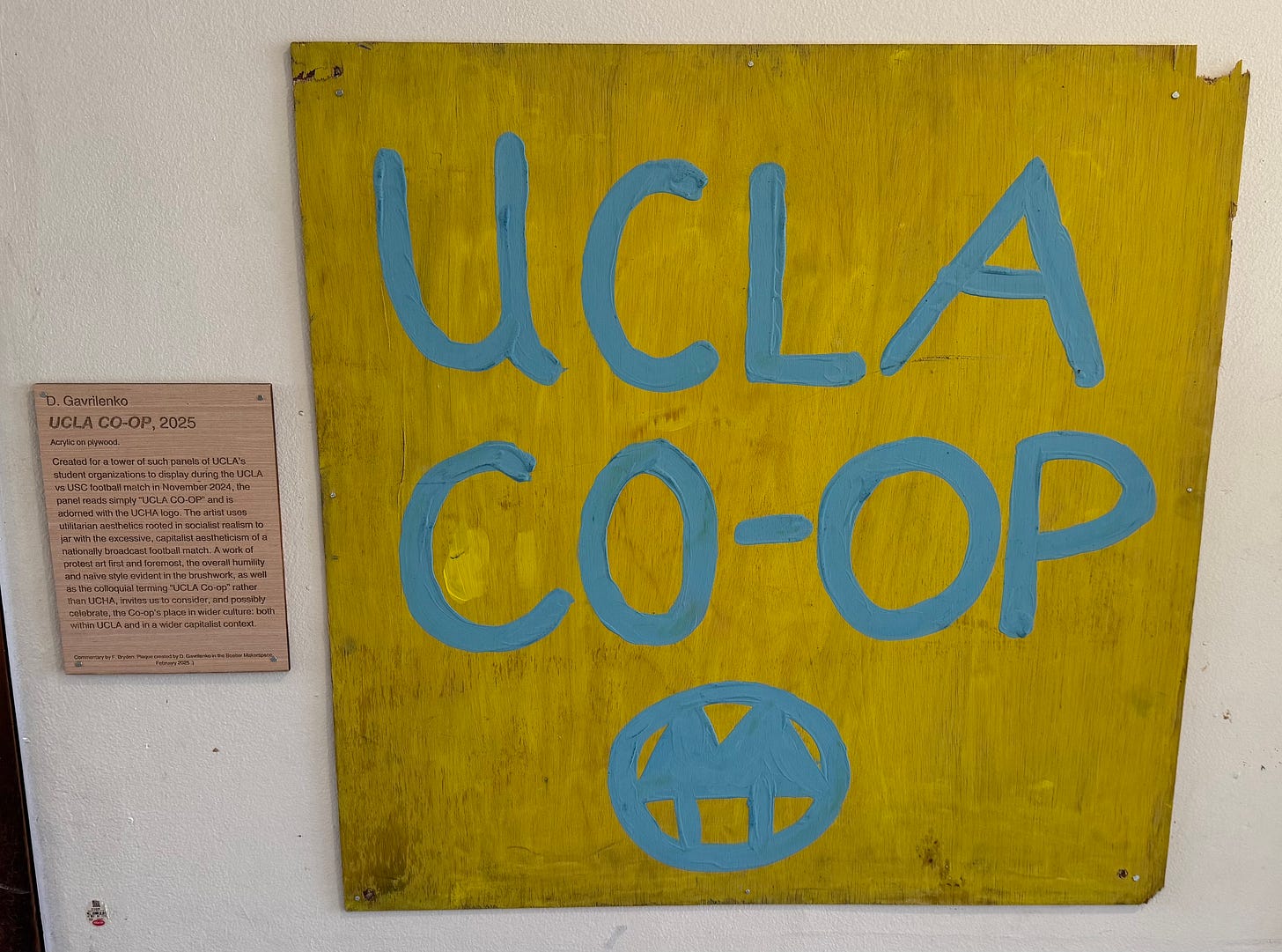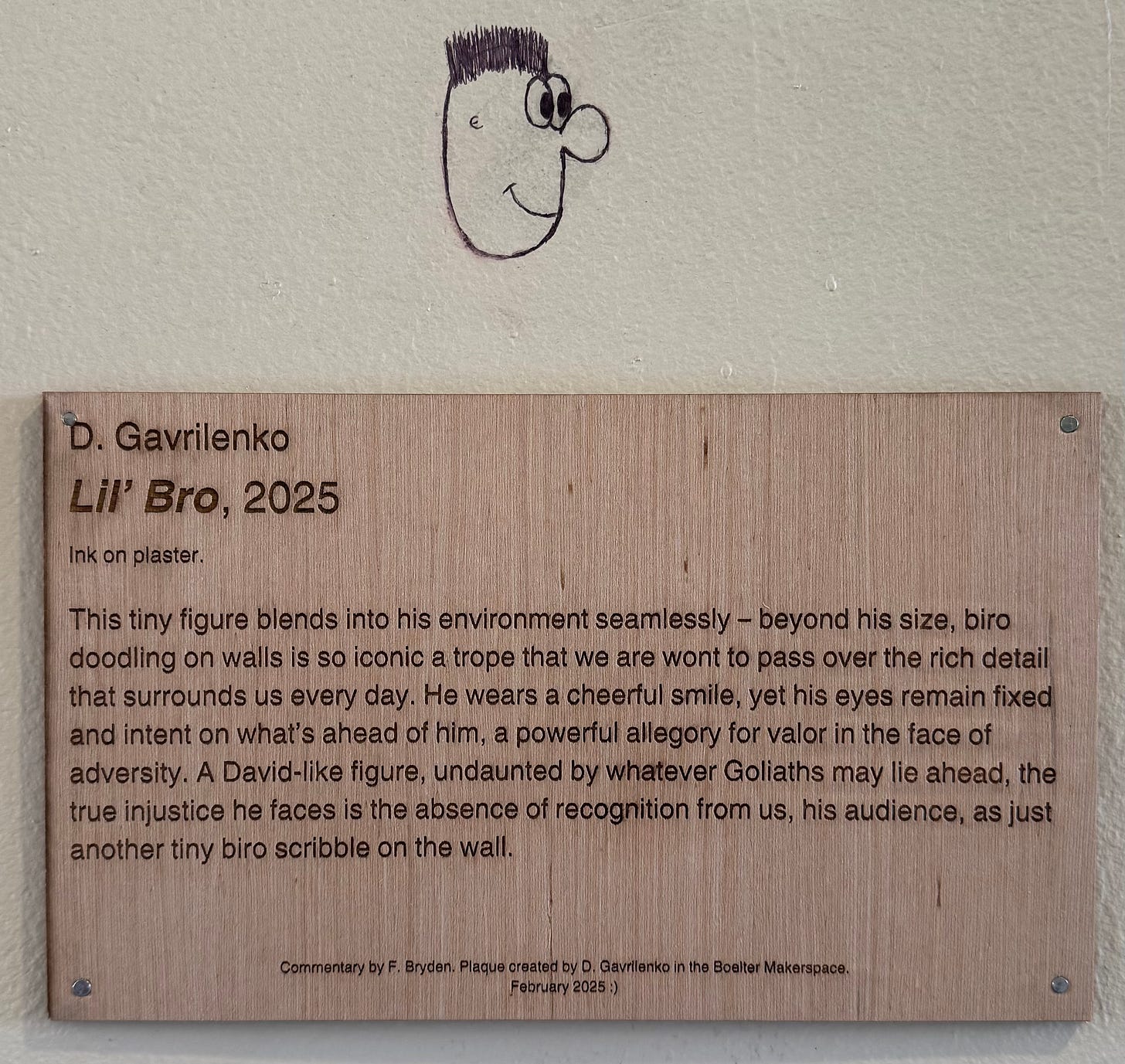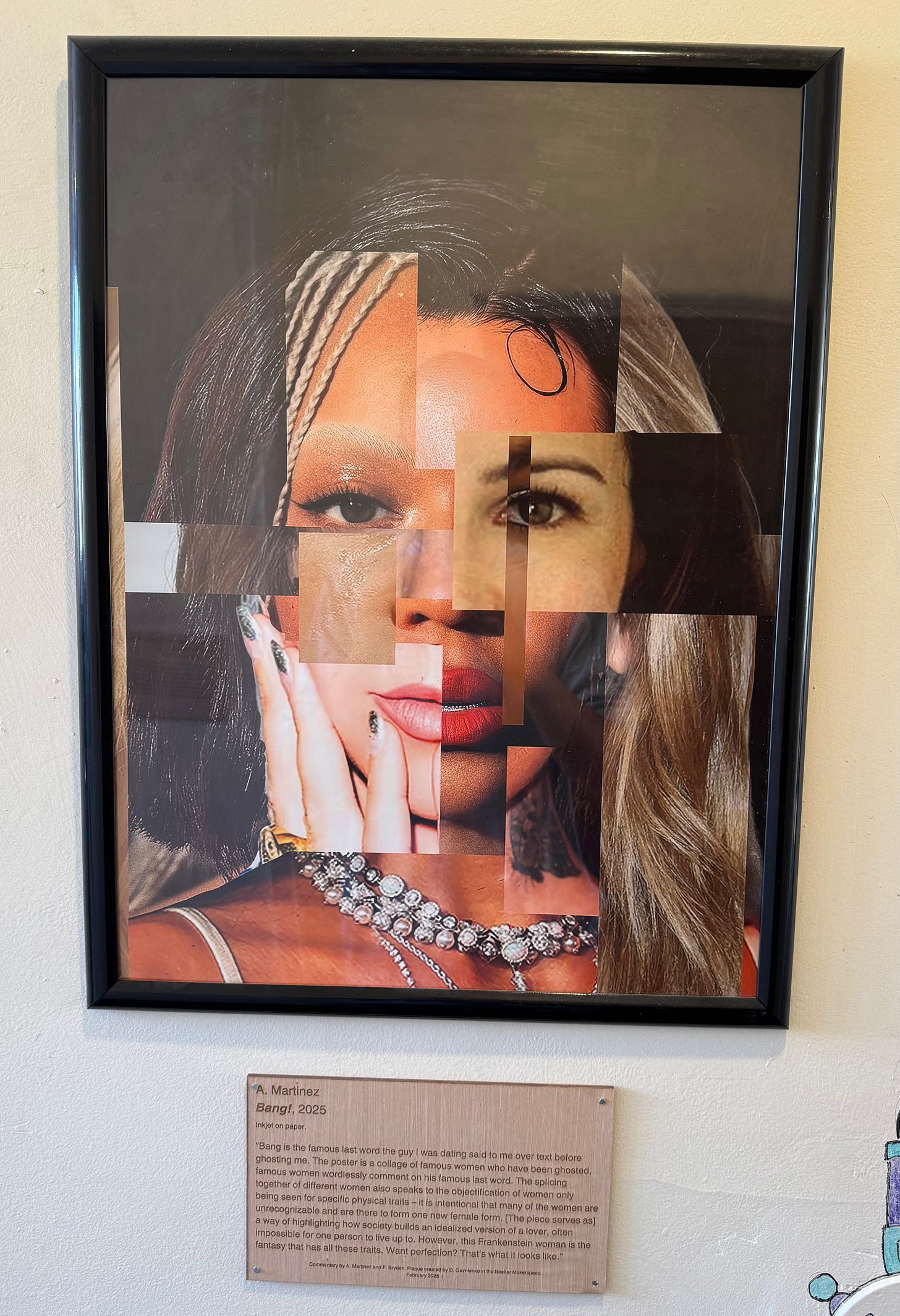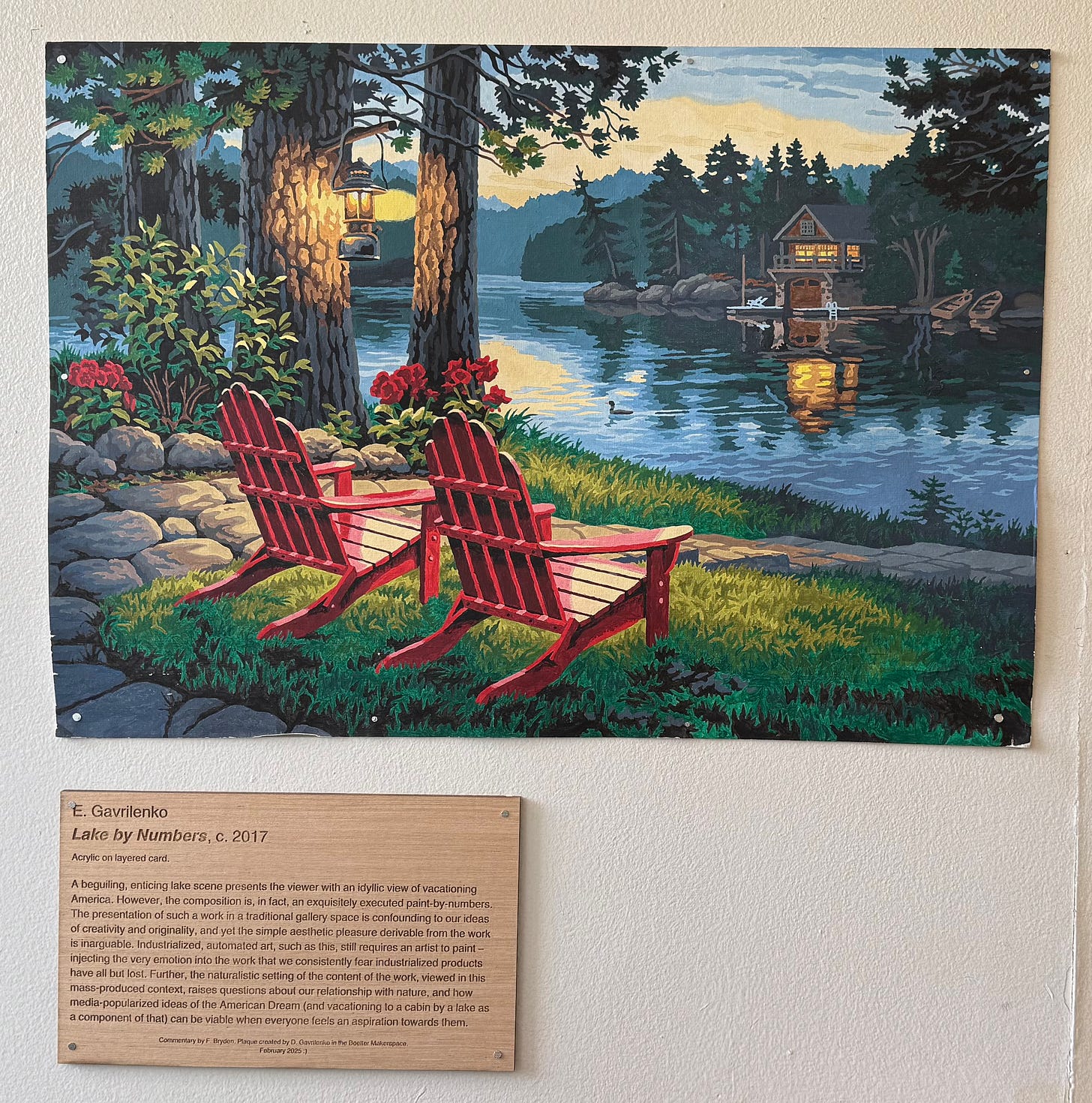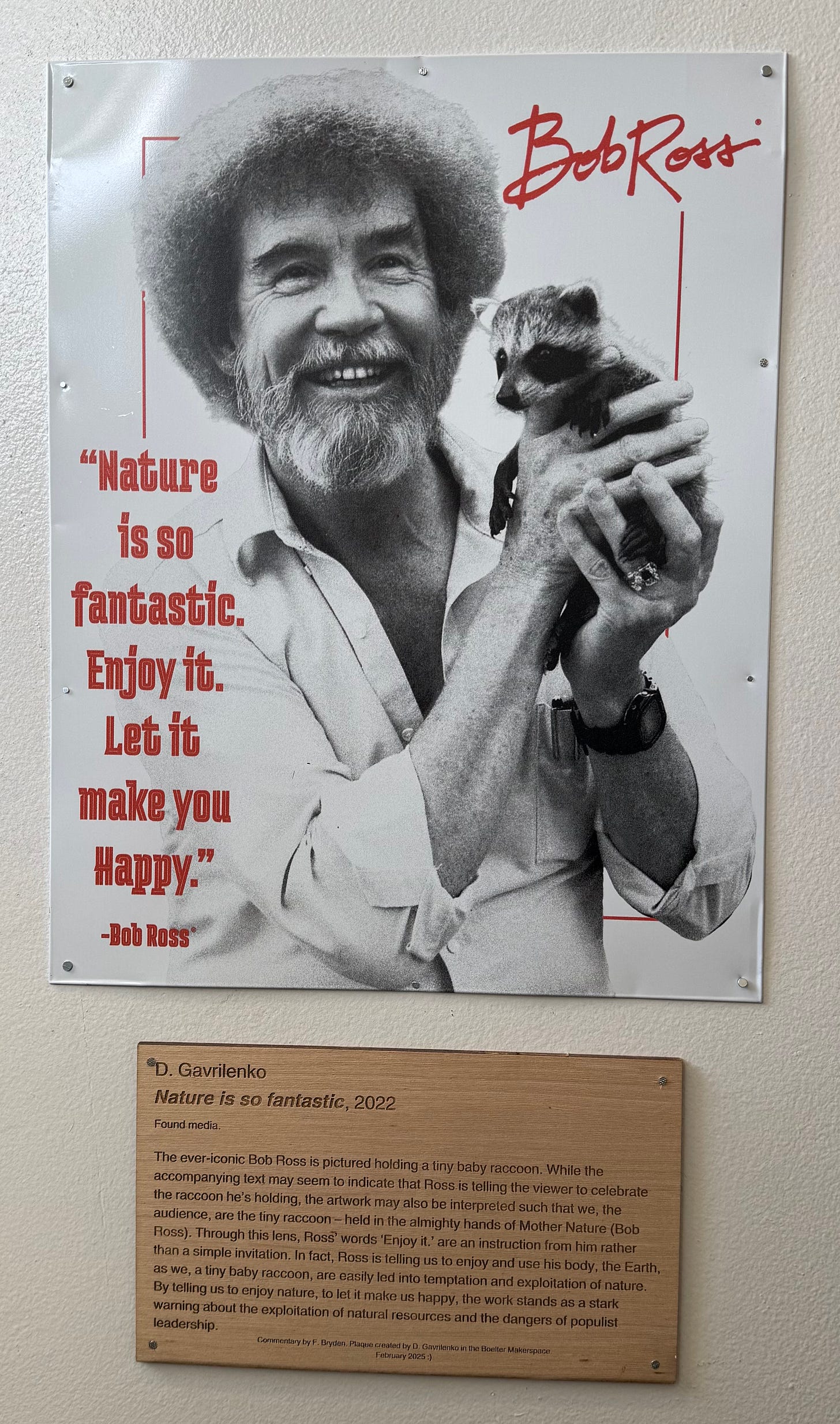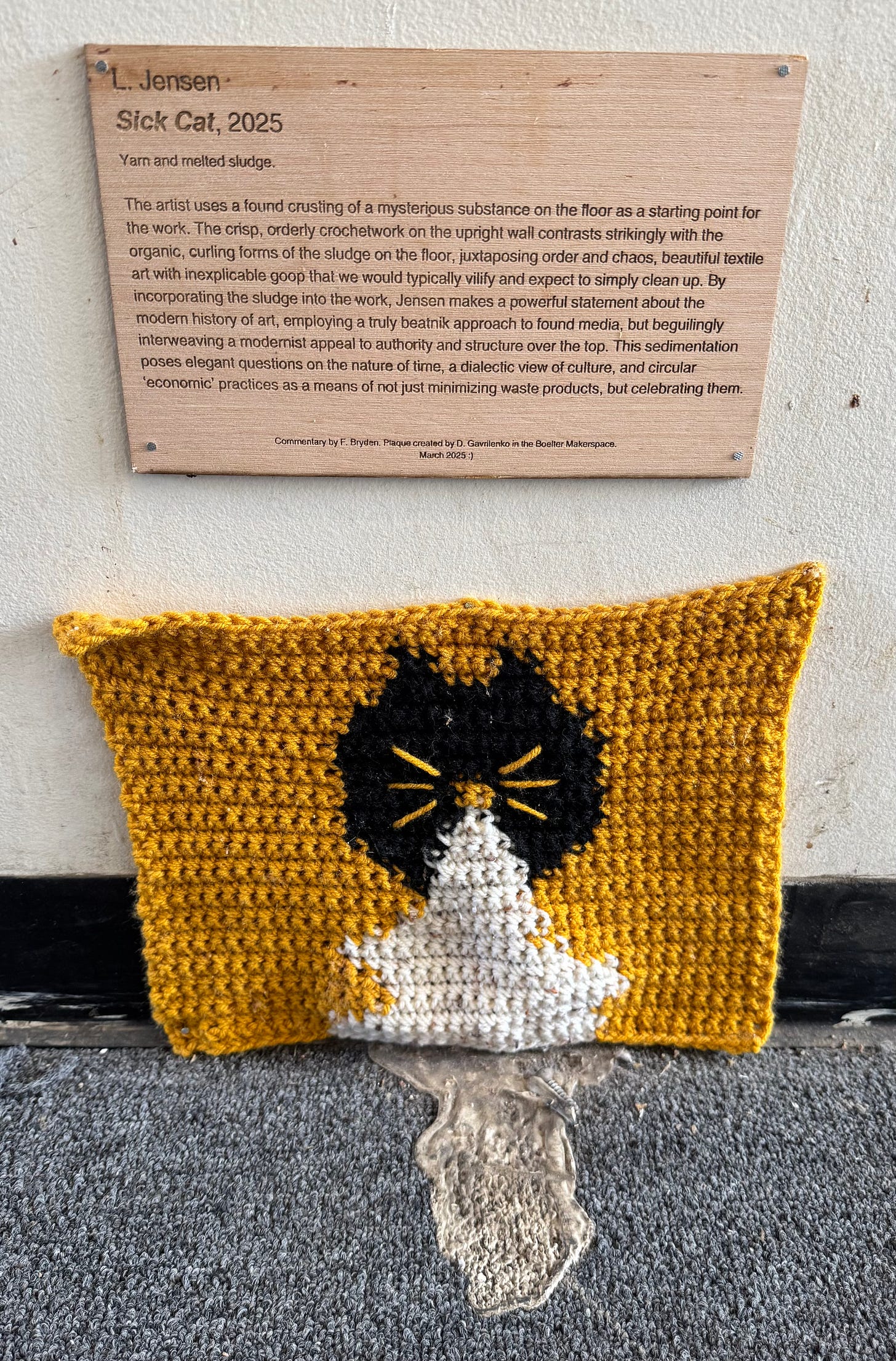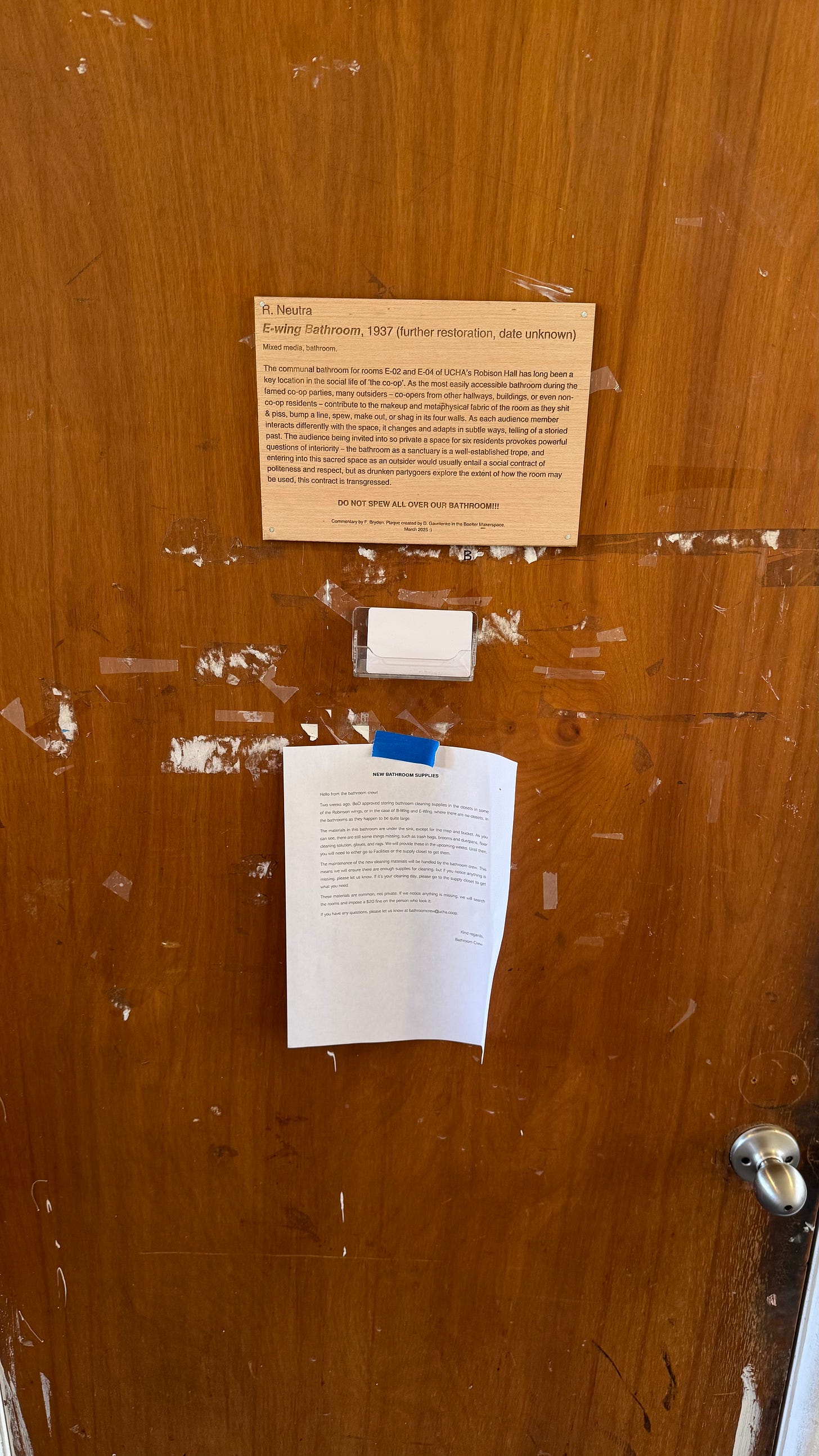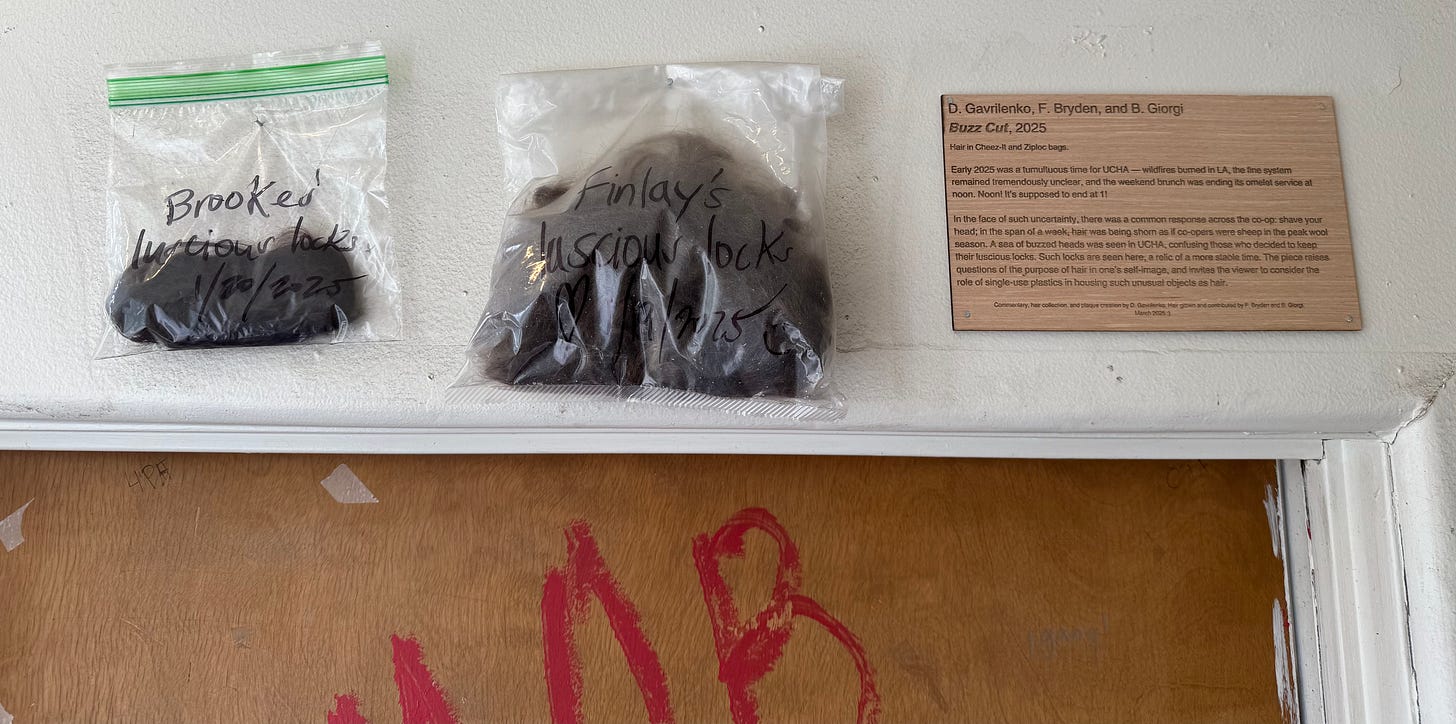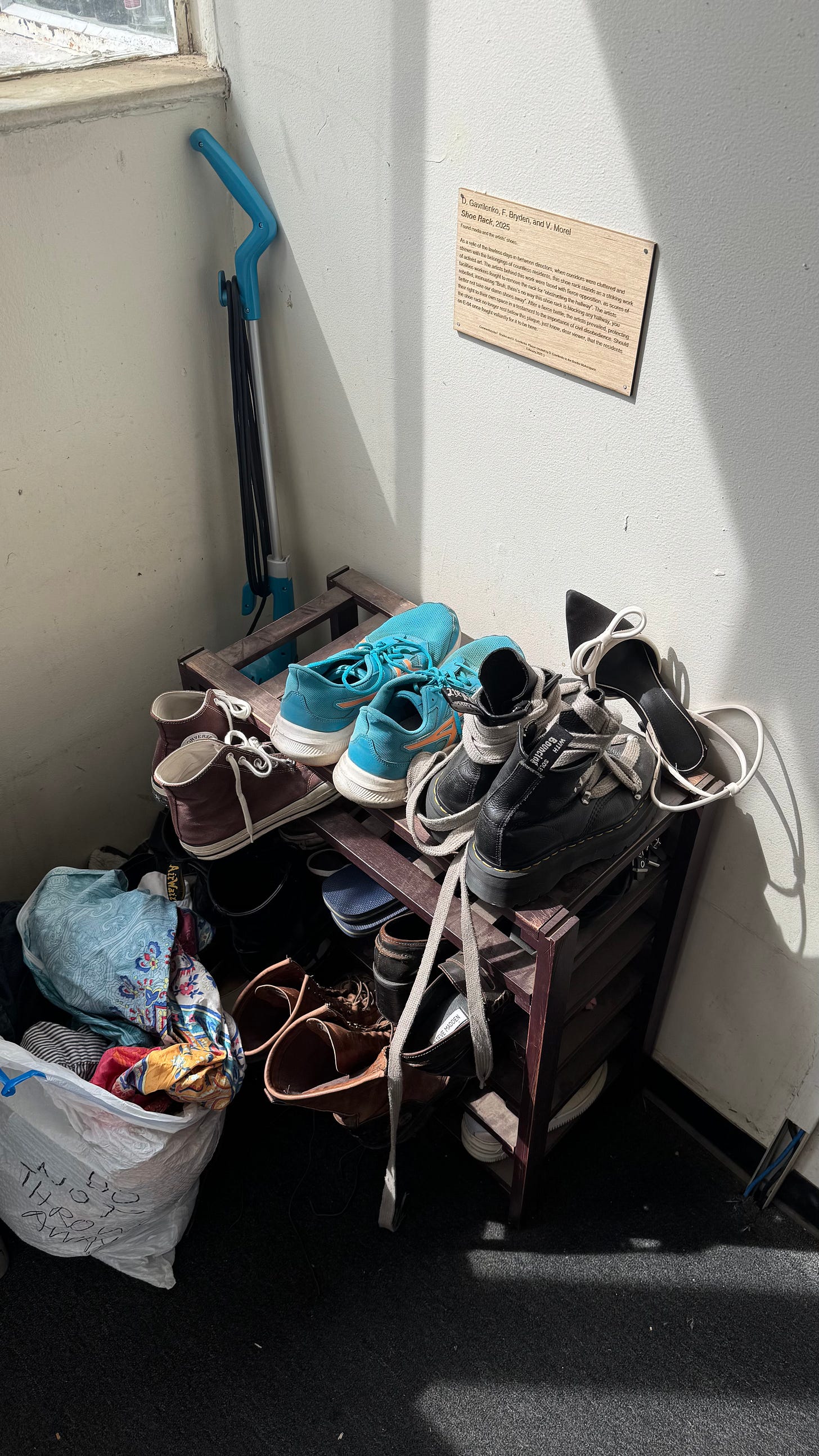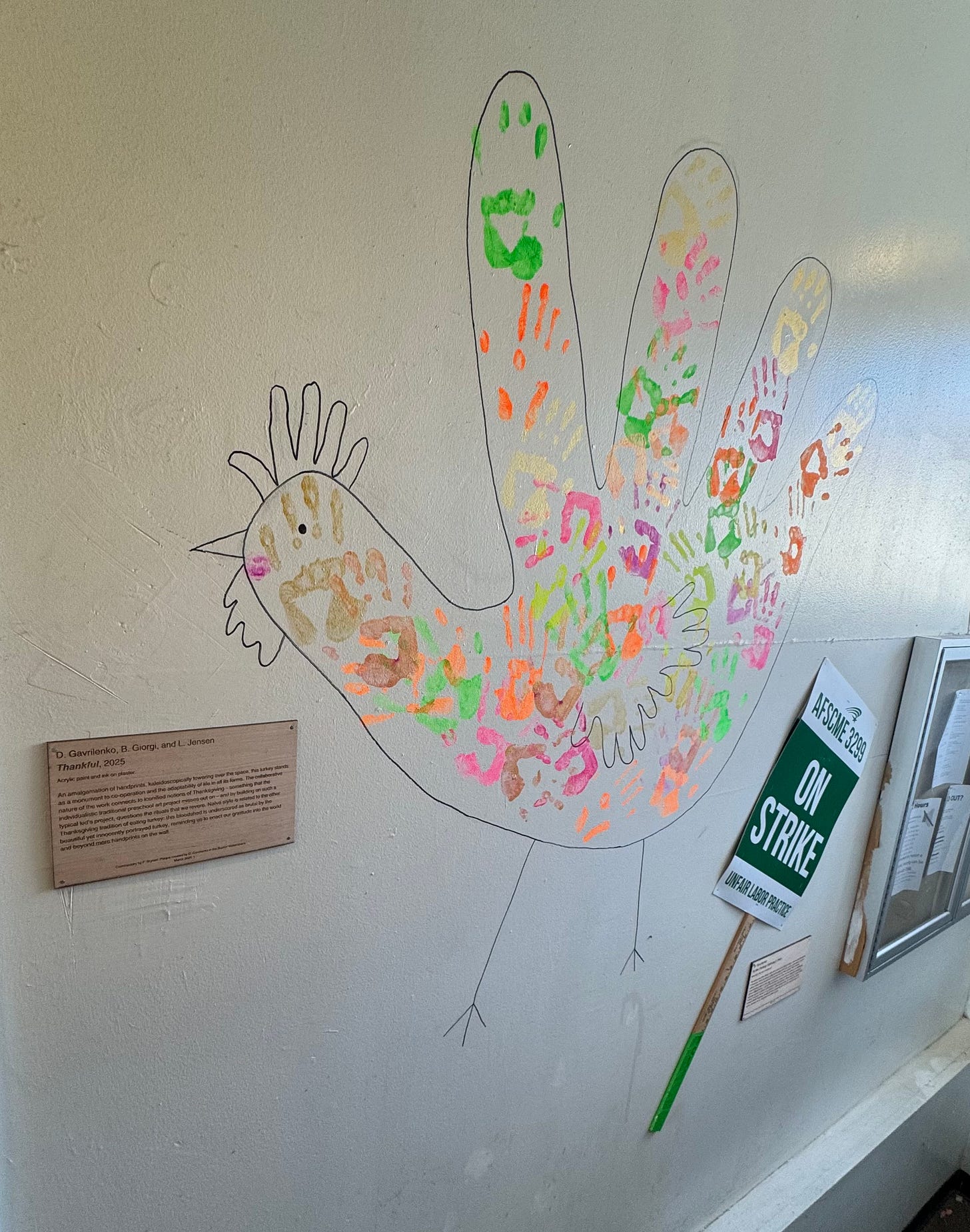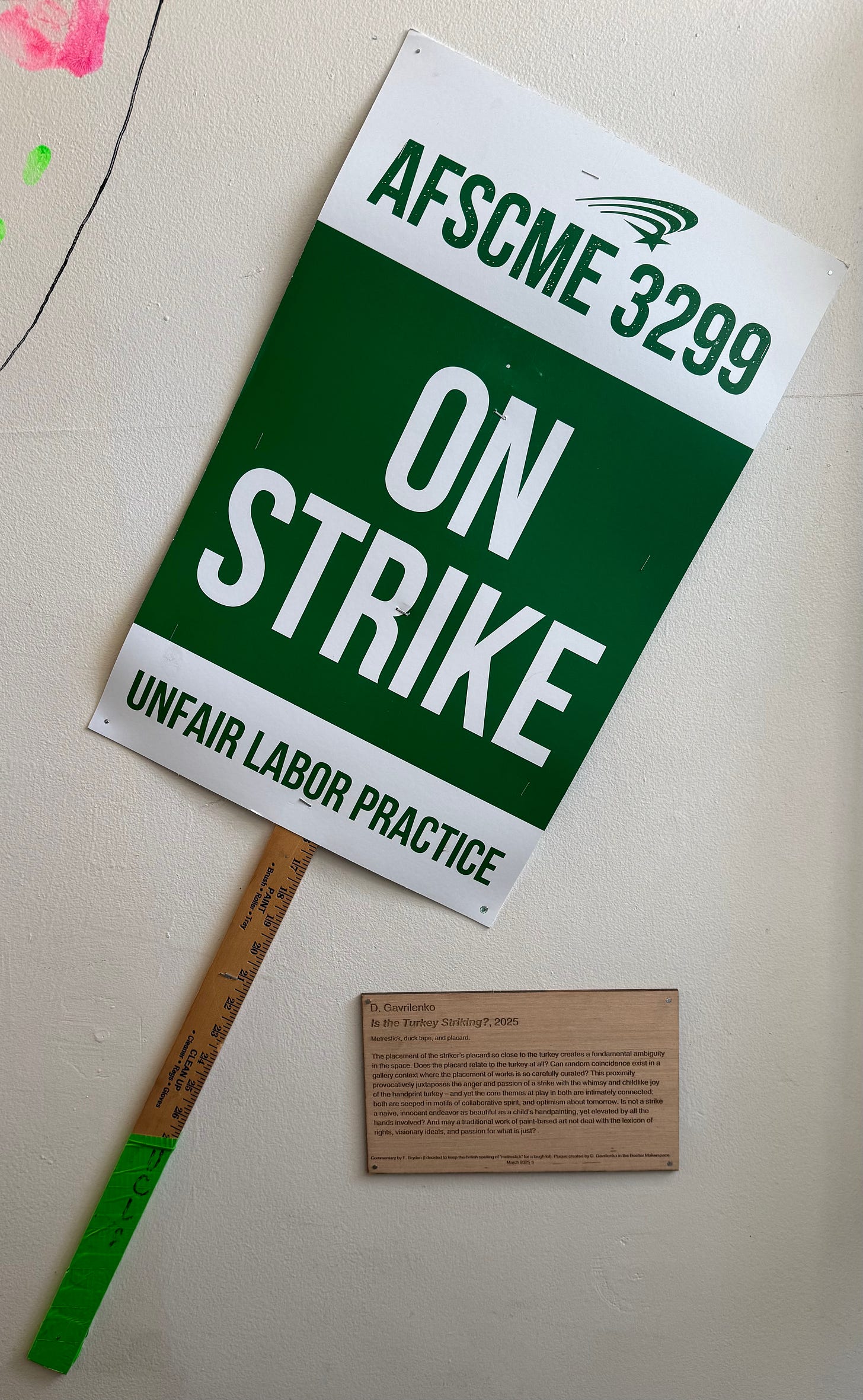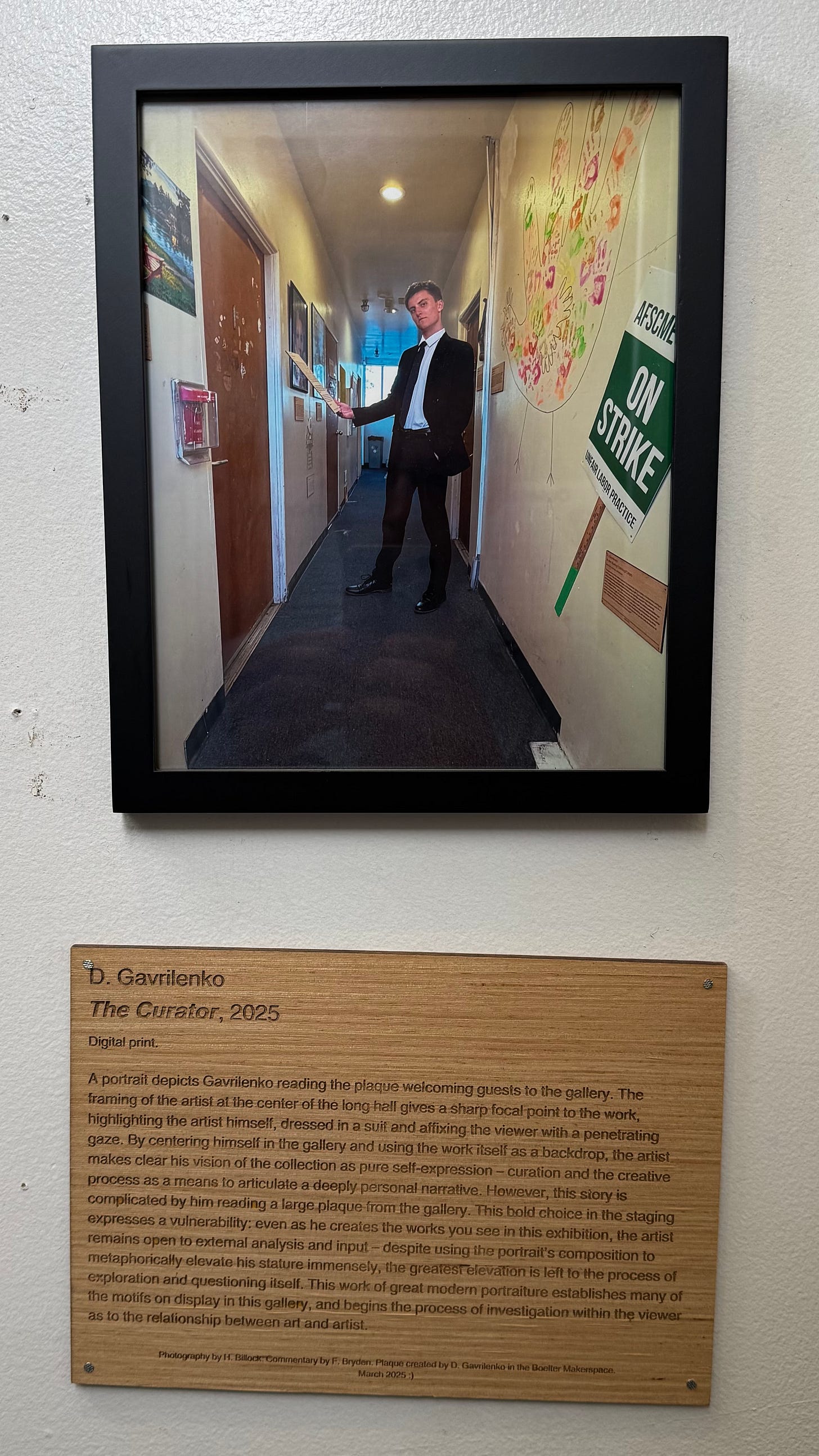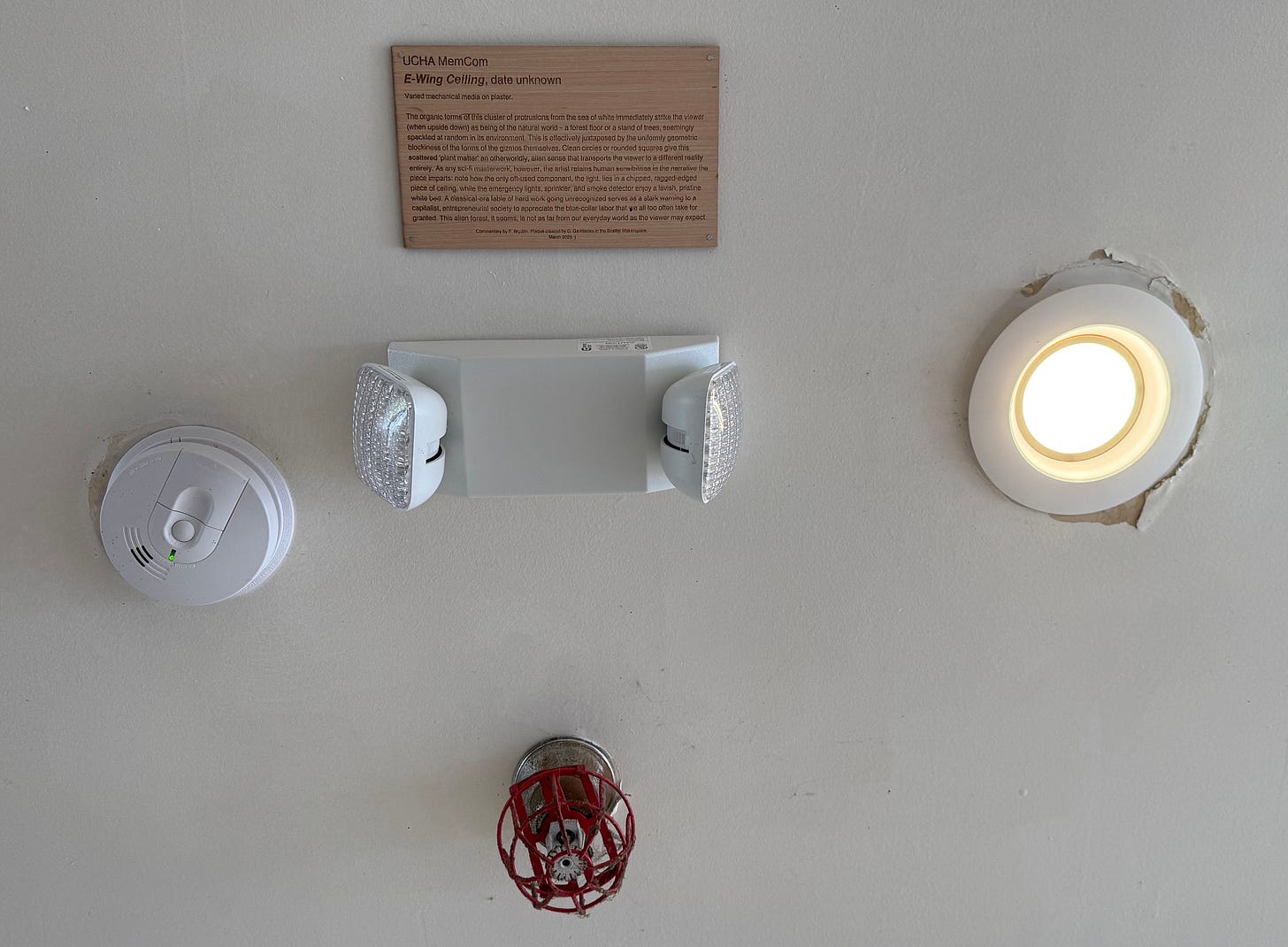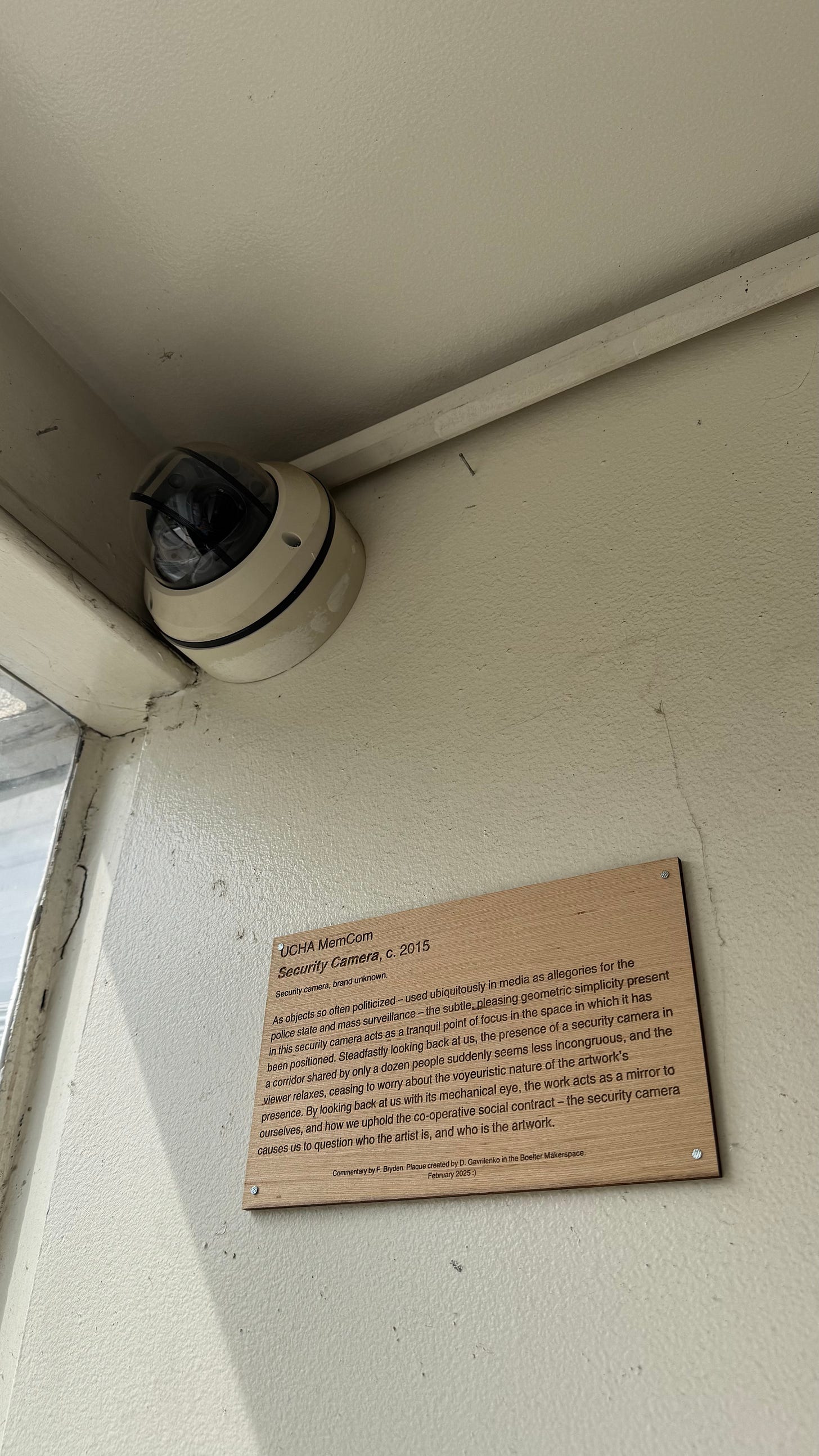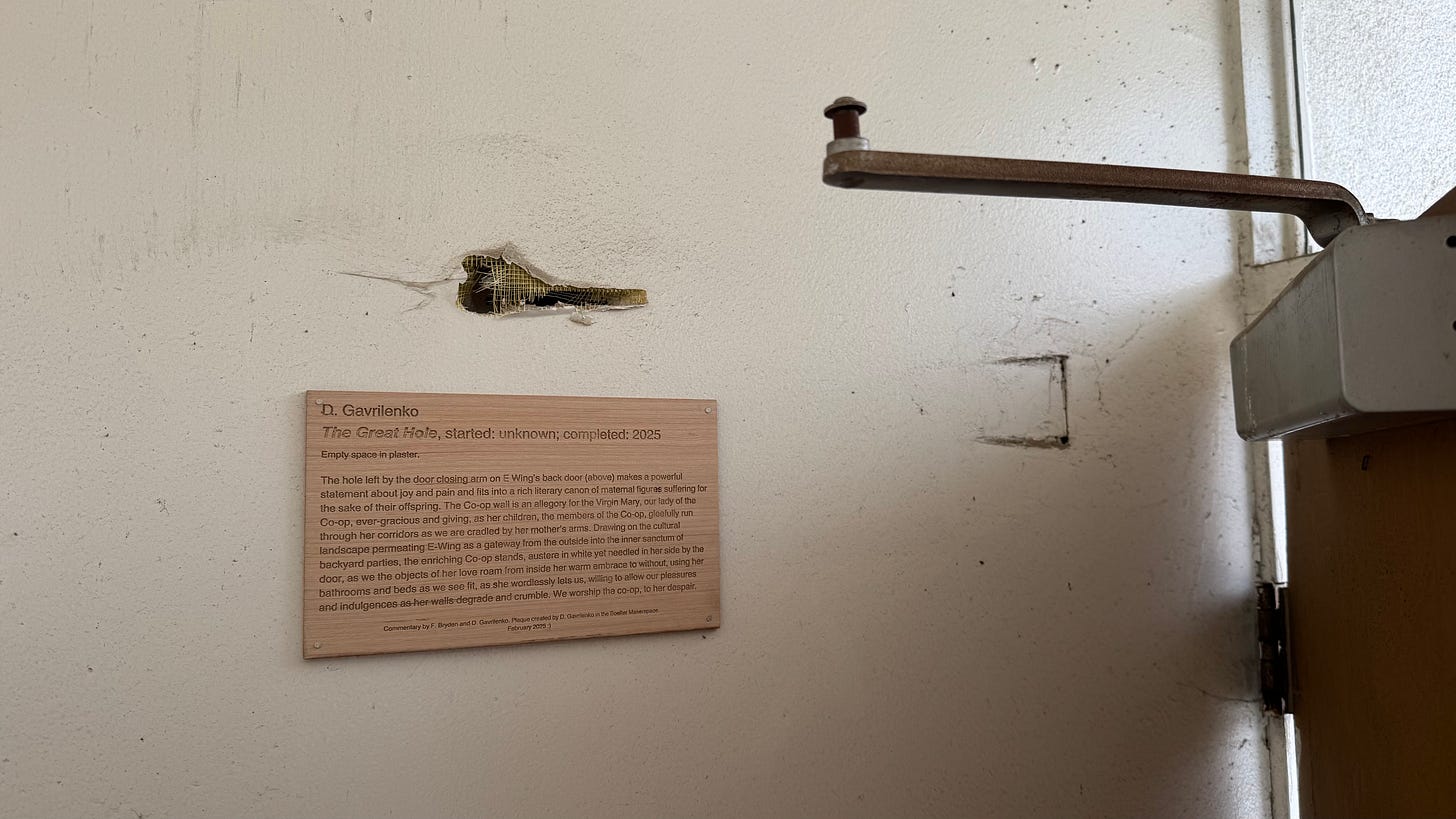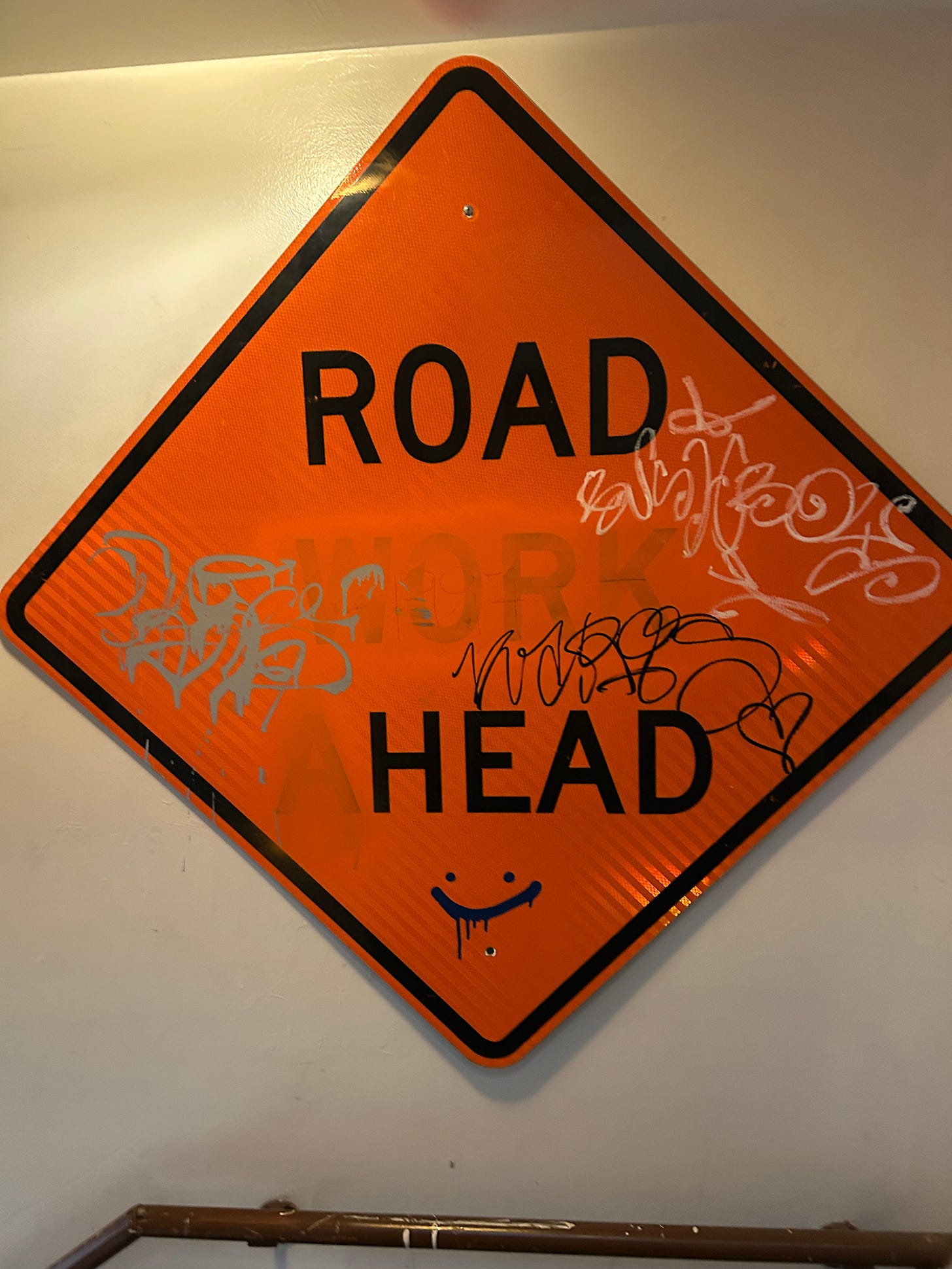The E-Wing Gallery 🖼️
Let me tell you about fleas...
This is the very first Adventure with Dennis episode that has an audio voiceover! Click the play button above to hear this piece read to you in my very own voice.
One of my dad’s favorite jokes is about a lazy biology student. The student doesn’t really go to class, but when he finds out that there’s a big exam the next day, he reluctantly cracks open his textbook to study.
He opens it to a random page, which just so happens to discuss fleas. After reading for a bit, the lazy student then goes to bed.
The next morning, he arrives at the exam hall, where the professor is waiting with a hat full of paper slips. Each student draws a slip, tells the professor about whatever is on it, and receives their grade for the exam.
Eventually, the lazy student makes it to the front of the line, and draws a card that says “cat”.
“Well professor, let me tell you about cats”, the student begins. “Cats are nice and fluffy, and make great house pets. Cats have a lot of fur, and on this fur live fleas. Let me tell you about fleas — they’re these tiny little animals, really terrible things. They drink your blood, can jump really high, and live for many …”
“Hold on hold on hold, wait a minute,” the professor butts in. “You’re supposed to tell me about cats, not fleas. Draw another slip and try again.”
The student draws another card — this one says “goat”.
“Well professor, let me tell you about goats”, the student begins again. “Goats are nice and friendly, and some people even have them as pets in their yard. Goats have horns and fur, and on this fur live fleas. Let me tell you about fleas — they’re these tiny little animals, really terrible things. They drink your blood, can jump really high, and live for many …”
“Wait a second!” the professor interrupts again. “What is it with these fleas?! Draw another slip and try again!”
The student draws one last card, and this one says “fish”.
“Well professor, let me tell you about fish”, the student begins again. “Fish are nice animals, real nice, and make great house pets. They go “blub blub” and make bubbles. I have a fish, his name is Tiny Tim. Tiny Tim doesn’t have fur, he has scales, but if he had fur, fleas would live there. Let me tell you about fleas — they’re these tiny little animals, really terrible things. They drink your blood, can jump really high, and live for many …”1
If you’ve spoken to me at all these past few months, you’ve probably noticed that I’m exactly like this lazy student. Except that instead of talking about fleas, I talk about my art gallery.
Within 5 sentences of any conversation, I bring up, “Hey, have I told you about the art gallery I’ve been curating in my hallway?”, to which you’d reply either by politely saying, “No I haven’t”, or by groaning and saying, “Dennis, you’ve told me about this gallery a million times already”.
Well professor, let me tell you about my gallery!
It may seem strange that I, of all people, spent my last quarter at UCLA curating an art gallery. I share your skepticism and slight disbelief. Though I was introduced to high art as a child and spent many years appreciating fine culture2, I never thought I’d be curating my own gallery in college. It’s not just that “Dennis curates an art gallery” wasn’t on my Bingo card. The thought hadn’t even crossed my mind.
And then one morning in early February, I was walking across Landfair Avenue to eat breakfast at the main co-op building when something caught my eye. There on the sidewalk, completely unexpectedly, lay several gallon-size Ziploc bags full of condoms. Hundreds of them. All expired. And all waiting to be thrown away.
Naturally, there was only one thing to do: rescue these condoms, and figure out what to do with them later. Those of you who have ever met me know that I’m a curious person, and this particular situation tickled this curiosity profoundly. Tickled it so hard, in fact, that my brain began to laugh.
I carried the first few bags back to my room, where I learned that fortunately, my girlfriend Brooke had already beaten me to the “figure out what to do with the condoms” task. Delightfully arranged on the floor outside my room was this lovely design:
Just like that, the inspiration for the E-Wing Gallery fell from the sky.
The University Cooperative Housing Association, or “the co-op”, may be my favorite place on Earth. Nestled among UCLA’s sprawling neighborhood of apartment blocks and private homes, three buildings are home to 450 students in the greatest slice of humanity I’ve ever encountered.
The co-op’s housing contracts are on a quarter-by-quarter basis, so tons of international and exchange students live there during their brief stints on campus. Rent is cheap, 19 delicious meals are provided each week, and there’s always something to do and someone to talk to.
Plus, there’s the tremendous benefit that the buildings, and everything in them, are all slightly falling apart. The building I lived in, Robison Hall, was built in the 1930s and declared a Los Angeles Cultural Monument for pioneering modern architecture in Westwood. It also looks like it was last repaired in the 1930s.
The best way to describe the co-op is as a communist utopia gone slightly wrong. It’s a beautiful place, full of culture, drama, dreams, and excitement. I love everything about it.
And out of all the things to appreciate about the co-op, one of my favorites is that all decorating is fair game. As long as your living space remains habitable and your renovations aren’t catastrophically dangerous, anything goes. It makes for an exciting living environment — earlier in the school year, my roommate Finlay and I repainted our entire room; the common spaces are filled with random collected furniture and artworks; and in the epic annals of co-op lore, the residents of the neighboring F-Wing once all massively tripped on acid and painted hallucinogenic murals across their entire hallway3. The co-op is a free-for-all.
It’s with this knowledge in mind that I found myself with a free afternoon and armed with hundreds of expired condoms. To top it all off, I had possession of Brooke’s hammer and had previously acquired several hundred free nails from the engineering building4. Brooke, Lise, Ana (Lise and Ana are roommates and fellow E-Wing residents), and I considered all of this information, and it was clear what we needed to do. Two hours later, the revolutionary artwork “Stay Safe Co-op” was completed:
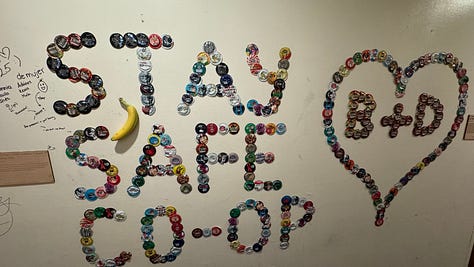
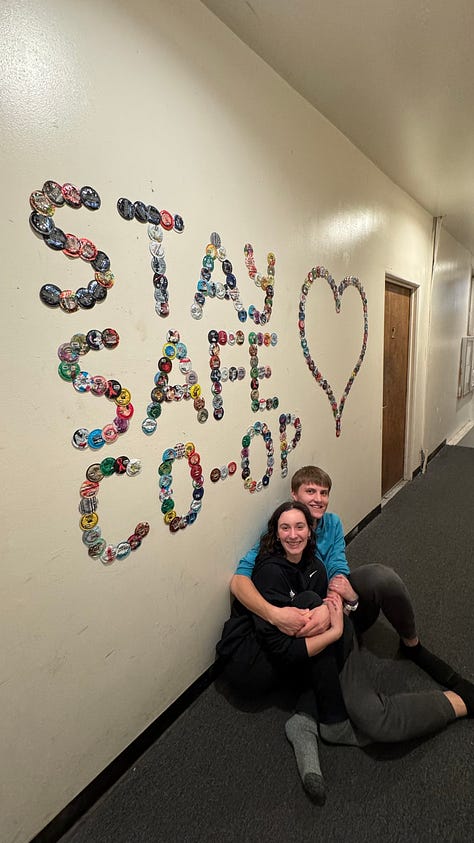
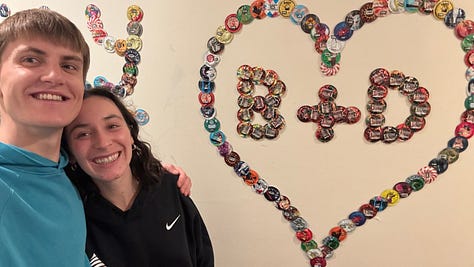
The only thing left was to make a plaque. After reading a ton about plaque creation5 and spending a lot of time in the UCLA Makerspace, I knew that I could pretty easily laser-cut a wooden plaque for “Stay Safe Co-op”. All I needed was someone to write me a blurb. I asked around the co-op to see if there were any art students who could write me one, but unfortunately, no one wanted to be associated with the condom wall and potentially damage their future artistic career.
But eventually, a lone figure rose from the ashes. The man, the myth, the legend (and my roommate) himself, Finlay. He studies physics, but after reading his philosophical pop culture analysis essays on his alter ego’s anonymous Substack (iykyk), I successfully convinced him to write me a plaque description for “Stay Safe Co-op”. Little did he know what he was signing up for.
Finlay wrote a blurb a few days later, and I headed to the engineering building to create this plaque. I had no idea how to actually do this, but the MechE students working there were super friendly and had me in tip-top shape in no time. I created a design of the plaque through Canva Pro, downloaded the design as an ultra-high-resolution PNG file, uploaded it to the laser cutting software, and 10 minutes later, had my birchwood plaque all ready to go6. I walked back to the co-op with my beautiful plaque in hand, and dramatically nailed it in place. The E-Wing Gallery was born.
After adding the plaque, I thought I was done — my artistic days were over, and I’d fondly recount how “back in my day, I made a condom wall artwork in my college hallway.” Yet, much to my surprise, it didn’t stop there.
Slowly but surely, I continued to add more artworks to the walkway, Finlay continued writing plaques for them, and I somehow kept justifying to myself that expanding this gallery was the best use of my time. I created some of the artworks, others I bought at flea markets or found wherever, and others still I commissioned from fellow residents of E-Wing. Classes became a second priority, and I’d wake up every day thinking about what new art to add to the walls, what funny quip or line to add to the plaques, what angle I could take for a new piece. I began dreaming of my gallery. I became the biology student, and the gallery became my flea. It consumed me, and filled me with the greatest joy.
Slowly but surely, the hallway began to fill up, the process of adding art and writing plaques continuing on and on and on. Until one day I woke up, and there was no wall space left. The E-Wing Gallery was complete, and my heart was full. With the help of the co-op’s social crew, I organized a late-March grand opening for the gallery the week before finals with an $80 budget, enough for several bottles of wine and a few bricks of brie cheese. I invited every single person I knew to attend. ~50 people showed up, and you could barely walk through the hallway from all the artistic connaisseurs appreciating the high culture of E-Wing. I was extremely proud, and even more grateful.
At the end of the day, it’s crazy how impactful the gallery was on my life. It became the defining aspect of my last quarter in college, and eventually, one of the most memorable experiences of my entire time at UCLA. It was a funny life chapter, an unexpected chapter, but one of my favorites nonetheless. It brought me closer to my friends at the co-op, and made me recognize what an amazing place it really is — one full of friendship, full of fellowship, with happiness permeating through every nook and cranny. What a truly special place.
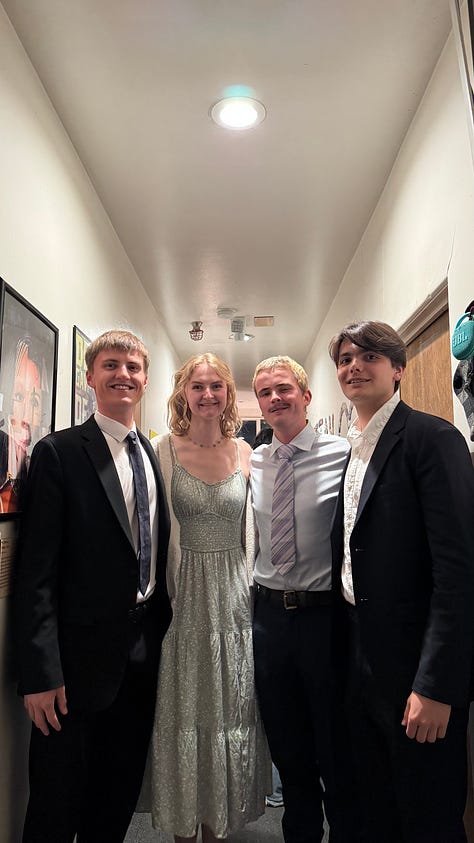
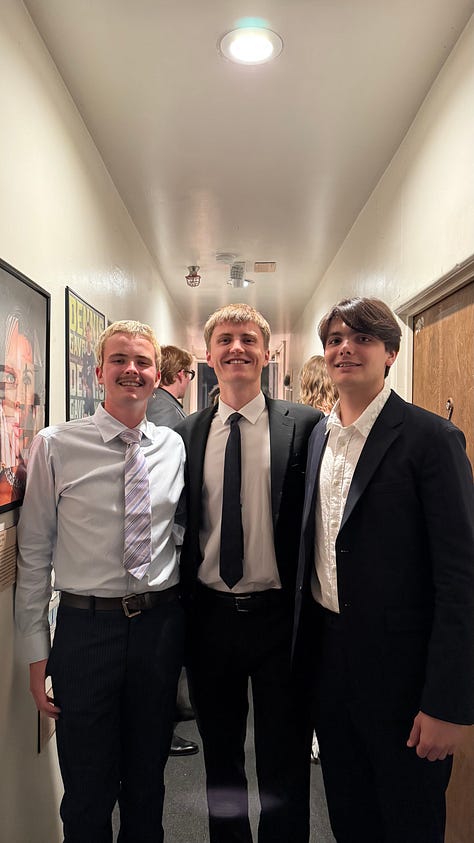
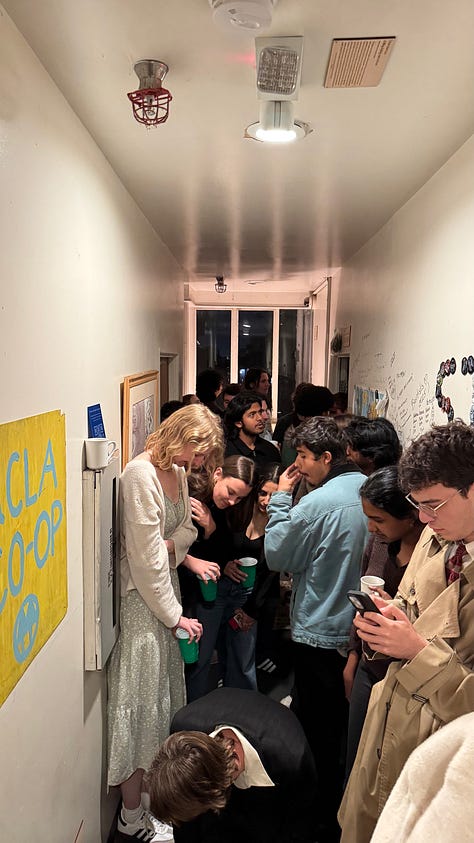
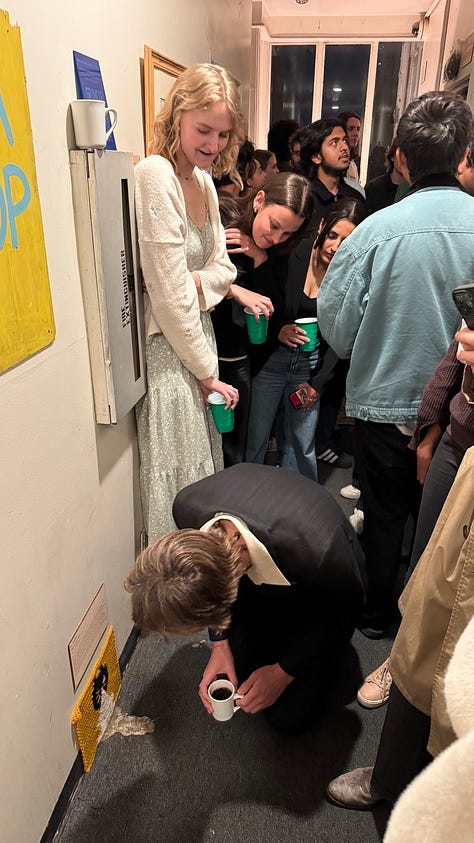
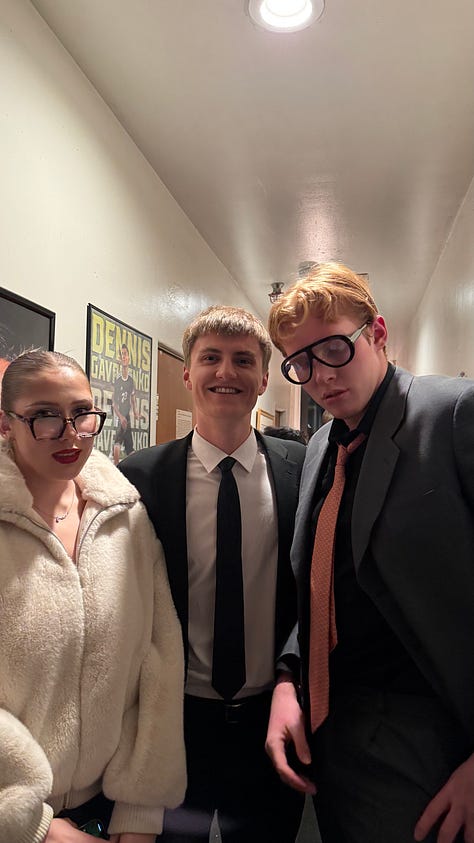

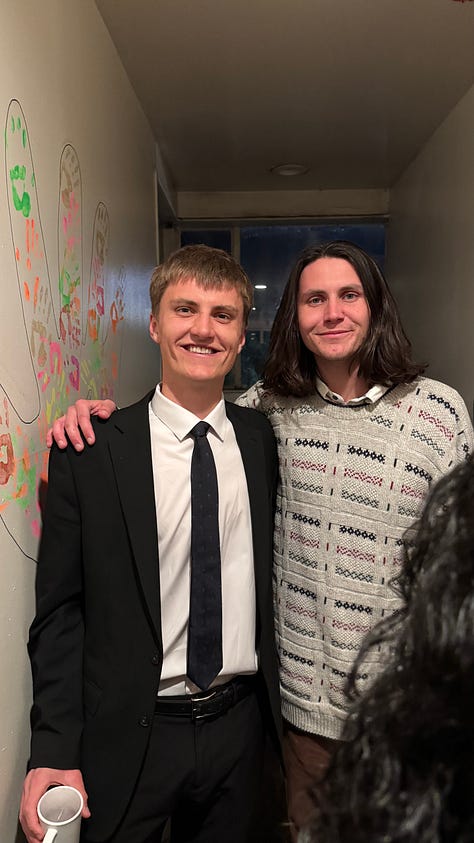
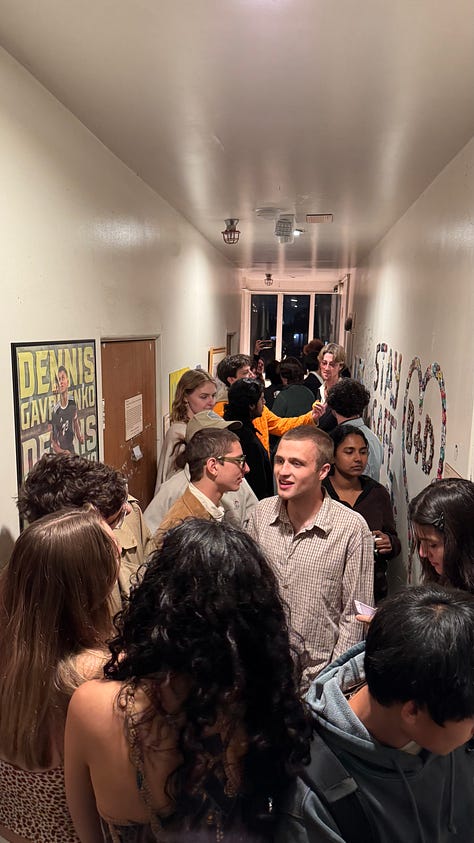
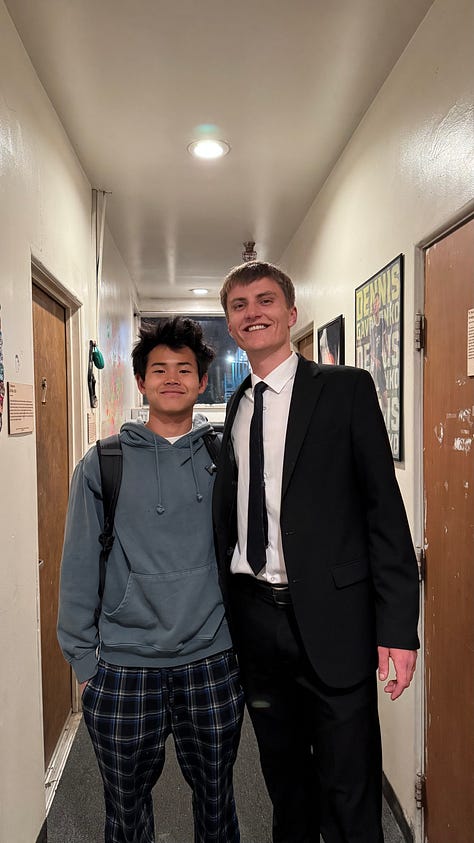
Of course, no gallery is complete without its artworks, and I’m very proud to share the entire collection of the E-Wing Gallery’s 24 artworks with you here.
It all started with “Stay Safe Co-op”, and I’ll highlight each piece in the order of its addition to the gallery. Each artwork will feature pictures of the art, the text of the plaques, and a narration of the plaque by the artist themselves. What a treat!
And though I try to do the gallery justice with these pictures, descriptions, and narrations below, nothing is quite like the real thing. If you’re in Westwood, come check out the gallery — just pull up to Robison Hall, find the door that says “E”, and walk on in. The artworks await!
Without further ado, the E-Wing Gallery:
1. Stay Safe Co-op
D. Gavrilenko, B. Giorgi, L. Jensen, A. Martinez, F. Bryden
Stay Safe Co-op, 2025
Condoms and nails on plaster.277 expired condoms raise questions of co-operation, patriarchal authoritarianism, and consent with the viewer: a symbol of sex and intimacy, the condoms have all been nailed twice. A co-operative safe sex project is subverted, and the line between our bodies and the co-operative structure is blurred.
Plaque created by Dennis Gavrilenko in the Boelter Makerspace, February 2025 :)
2. Notre Monde
D. Gavrilenko
Notre Monde, 2025
Map, stickers, and calligraphy on plaster.Drawing on a tradition seen in travelers' hostels worldwide, the artist (a Californian) invites us to investigate our relationship with globalization, particularly in an academic and co-operative context. While UCHA, and UCLA more broadly, today are profoundly international organizations, it has not always been this way, and may not be in the future. An intensely political message masquerades as a quaint, innocuous diversion.
A few weeks before we made Stay Safe Co-op, I put up a world map outside my room for co-opers to put gold stars on their home countries. I wrote “Where are you from” with a Sharpie in several languages on the wall next to it, and left the pen there to encourage similar linguistic graffiti. I figured that since the co-op is so international, it’d make for a beautiful kaleidoscope of stars across the world and phrases across the wall, and it turned out even better than expected.
The result? Notre Monde. Our world.
3. Clandescence
D. Gavrilenko
Clandescence, 2025
Found media.While searching a flea market for a picture of a nude lady, the artist arrived upon this piece. Arresting in its deceptive simplicity, the work confounds expectations of erotic naked imagery typical in dorm-room settings by challenging what we interpret as the female body and the sexual objectification of forms. The function of art as erotic or decorative is scrutinized, and the symbolic form that we consider 'artwork' is interrogated to complicate the line between high art and décor.
Commentary by F. Bryden. Plaque created by D. Gavrilenko in the Boelter Makerspace. February 2025 :)
In mid-February, I went to the Rose Bowl flea market with some friends to check out the famous event and to have some fun. Of course, I Strava-ed the entire walk around the stadium, and had the best time checking out everything being sold.
I wanted to see if I could find something for the gallery, and also wanted to haggle for a laugh. All the paintings I was looking for were much too expensive, but this bad boy was on sale for $10 and successfully haggled down to $5. Lit. The story behind Clandescence is one of my favorites, and Finlay had a field day writing the plaque for this one.
4. UCLA CO-OP
D. Gavrilenko
UCLA CO-OP, 2025
Acrylic on plywood.Created for a tower of such panels of UCLA's student organizations to display during the UCLA vs USC football match in November 2024, the panel reads simply "UCLA CO-OP" and is adorned with the UCHA logo. The artist uses utilitarian aesthetics rooted in socialist realism to jar with the excessive, capitalist aestheticism of a nationally broadcast football match. A work of protest art first and foremost, the overall humility and naïve style evident in the brushwork, as well as the colloquial terming "UCLA Co-op" rather than UCHA, invites us to consider, and possibly celebrate, the Co-op's place in wider culture: both within UCLA and in a wider capitalist context.
Commentary by F. Bryden. Plaque created by D. Gavrilenko in the Boelter Makerspace. February 2025 :)
I made this panel for the Beat ‘SC rally last November, and retrieved it after the plywood tower was taken down the next day. It was left in the main lobby of the co-op for a few months, rotting away.
Until I started curating my gallery and found the perfect piece for it, one that I’d created long ago.
5. Lil’ Bro
D. Gavrilenko
Lil' Bro, 2025
Ink on plaster.This tiny figure blends into his environment seamlessly - beyond his size, biro doodling on walls is so iconic a trope that we are wont to pass over the rich detail that surrounds us every day. He wears a cheerful smile, yet his eyes remain fixed and intent on what's ahead of him, a powerful allegory for valor in the face of adversity. A David-like figure, undaunted by whatever Goliaths may lie ahead, the true injustice he faces is the absence of recognition from us, his audience, as just another tiny biro scribble on the wall.
Commentary by F. Bryden. Plaque created by D. Gavrilenko in the Boelter Makerspace. February 2025 :)
Lil’ Bro is by far my favorite piece in the entire gallery. I had seen a similar scribble somewhere long ago and decided to have some fun and draw directly on the wall, too. Finlay really cooked with this plaque, and it’s one of the few that I have memorized by heart and randomly recite every so often.
Lil’ Bro, my hero.
6. Bang!
A. Martinez
Bang!, 2025
Inkjet on paper.Bang is the famous last word the guy I was dating said to me over text before ghosting me. The poster is a collage of famous women who have been ghosted, famous women wordlessly comment on his famous last word. The splicing together of different women also speaks to the objectification of women only being seen for specific physical traits - it is intentional that many of the women are unrecognizable and are there to form one new female form. [The piece serves as] a way of highlighting how society builds an idealized version of a lover, often impossible for one person to live up to. However, this Frankenstein woman is the fantasy that has all these traits. Want perfection? That's what it looks like.
Commentary by A. Martinez and F. Bryden. Plaque created by D. Gavrilenko in the Boelter Makerspace. February 2025 :)
Bang! was the first commissioned piece for the gallery, created by my fellow E-Winger Ana. We’d chat in the hallway often, and gossip like crazy. I was blown away by how amazing Bang! turned out, and it inspired me to get everyone in the hallway to create their own piece, too.
7. Portrait of Dennis Gavrilenko
J. Giddings
Portrait of Dennis Gavrilenko, 2021
Inkjet on paper.Created as a gift to the subject, the portrait displays Gavrilenko as a star of the soccer (football) field, complete with the team captain's armband and in a stance ready to command control of the ball. The aggrandizing composition stages the subject as a heroic figure, with his name writ large three times in the middie ground. As curator of the gallery the work now resides in, Gavrilenko's choice to include the piece asks the viewer to consider the interplay between gallery spaces and the creative quest of the artist. The creator as a narcissus serves to comment on the art industry as a whole, and how the role of traditional background figures in exhibits exerts agency and shifts perspectives in seemingly open-to-interpret artworks and collections.
Commentary by F. Bryden. Plaque created by D. Gavrilenko in the Boelter Makerspace. February 2025 :)
This portrait was created by Joseph, my friend, fellow Eagle Scout, and high school cross-country teammate. He made two of these portraits for me years ago, and I decided that one of them would be a perfect addition to the gallery. After a weekend visit home, I brought one down to hang on the wall.
8. In Crisis
D. Gavrilenko
In Crisis, 2025
Graphite and wax on plaster.By anthropomorphizing the iconic pop-cultural debate of the taxonomy of hot dogs in layered carbohydrate-protein composites (bread), the artist makes us question our relationship to ourselves, our bodies, and with God. Bold diagonal lines in the composition underscore the precarious nature of humankind in our existential task to fill our lives with meaning, as the genuflecting hot dog ambiguously asks themself, the world, or the Heavens for an answer. As a common Co-op lunch, 'the Heavens' implied in the work is likely the Co-op cafeteria, further complicating our relationship with the work as viewers, participating in the life cycle of the hot dog. The hot dog desperately seeks to fill their life with meaning, as we as God-like figures find meaning ourselves by consuming sandwiches and hot dogs indiscriminately. The work poignantly asks us to reflect on the Western turn away from a 'God' in a post-existentialist world, and how we may live a moral life in the absence of organized religion.
Commentary by F. Bryden. Plaque created by D. Gavrilenko in the Boelter Makerspace. February 2025 :)
At this point in the gallery creation, I started becoming obsessed with filling all the empty wall space in our corridor with “art”. No, art. If you say it’s art, it’s art.
I sketched this one on the wall in pencil, borrowed some colored pencils, and we were all good to go. This one was directly across the hallway from our room, so it’d be the first thing I’d see each time I walked out of the room. lol
9. Where to?
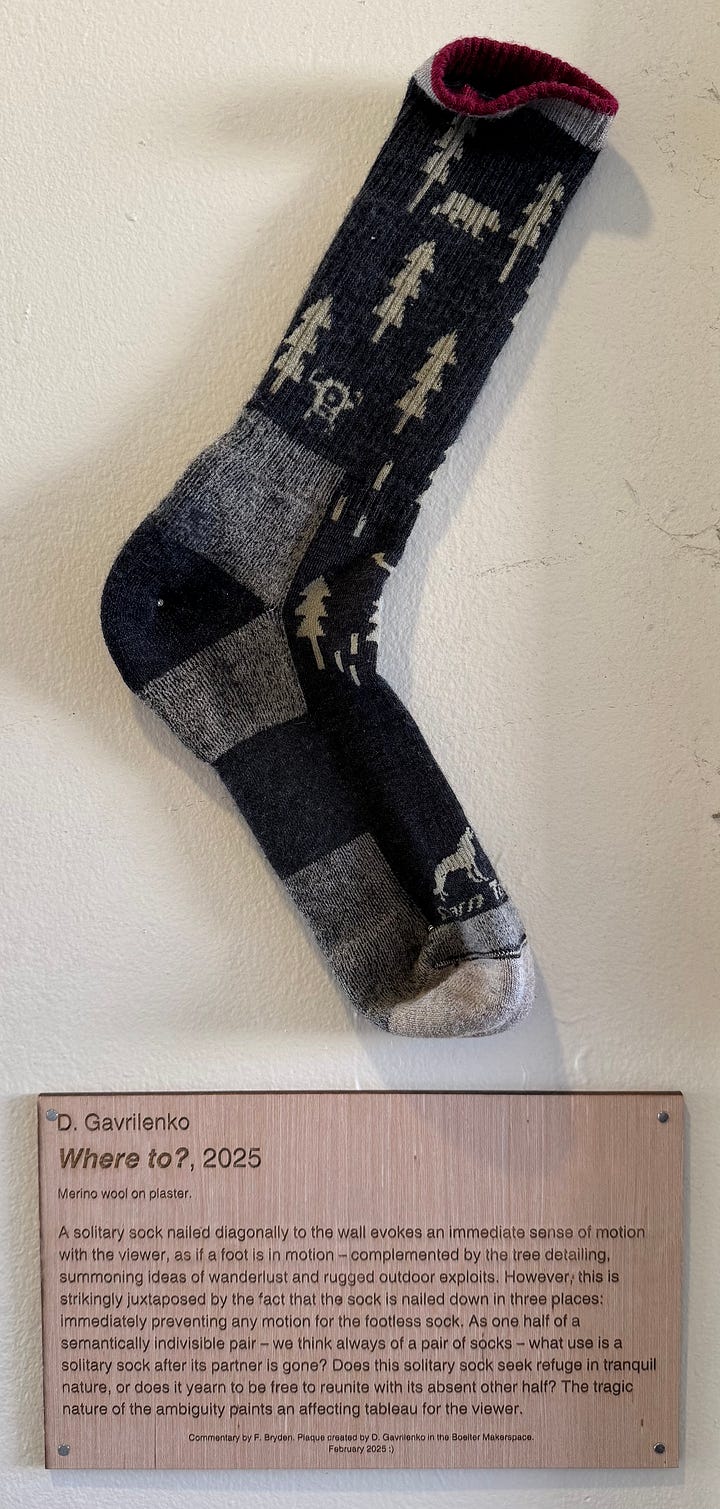
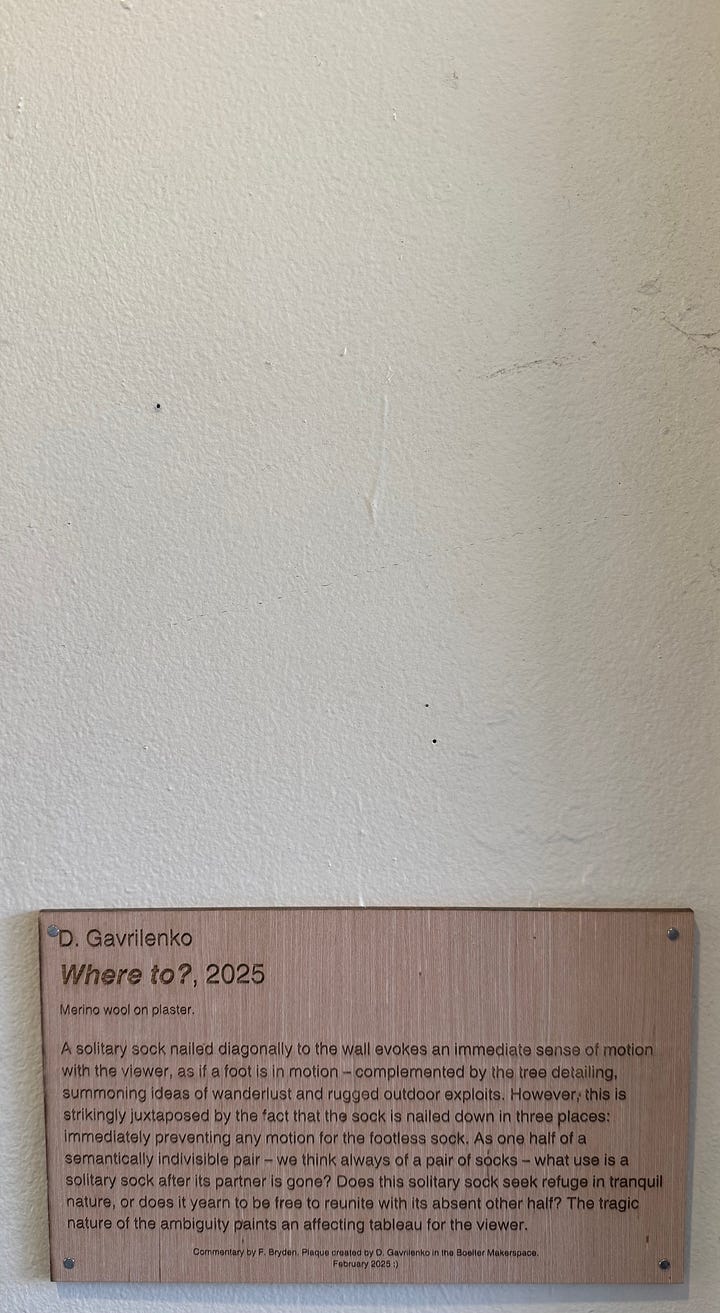
D. Gavrilenko
Where to?, 2025
Merino wool on plaster.A solitary sock nailed diagonally to the wall evokes an immediate sense of motion with the viewer, as if a foot is in motion - complemented by the tree detailing, summoning ideas of wanderlust and rugged outdoor exploits. However, this is strikingly juxtaposed by the fact that the sock is nailed down in three places: immediately preventing any motion for the footless sock. As one half of a semantically indivisible pair - we think always of a pair of socks - what use is a solitary sock after its partner is gone? Does this solitary sock seek refuge in tranquil nature,or does it yearn to be free to reunite with its absent other half? The tragic nature of the ambiguity paints an affecting tableau for the viewer.
Commentary by F. Bryden. Plaque created by D. Gavrilenko in the Boelter Makerspace. February 2025 :)
The backstory of this one was crazy. I found the solitary sock in my clean laundry in mid-February (this happened many times throughout college), and since it was pretty nice, I didn’t throw it away immediately. A few weeks later, I started curating my gallery, and thought it’d be funny to include the sock with an accompanying plaque.
Fast forward to the grand opening of the gallery, a friend I invited revealed that it was actually his sock, which he had lost two months ago after we went on a camping trip with five other people. He asked for it back, and I jokingly responded that I’d buy him new socks since I wasn’t taking down the gallery during its grand opening.
Following some shady intrigue, an excessive amount of ethical philosophizing on my end, and too many conversations about this dilemma with anyone and everyone I knew, he got his sock back, leaving an empty ghost on the wall. Now, only a remnant remains of my beloved, Where to?
10. Lake by Numbers
E. Gavrilenko
Lake by Numbers, с. 2017
Acrylic on layered card.A beguiling, enticing lake scene presents the viewer with an idyllic view of vacationing America. However, the composition is, in fact, an exquisitely executed paint-by-numbers. The presentation of such a work in a traditional gallery space is confounding to our ideas of creativity and originality, and yet the simple aesthetic pleasure derivable from the work is inarguable. Industrialized, automated art, such as this, still requires an artist to paint - injecting the very emotion into the work that we consistently fear industrialized products have all but lost. Further, the naturalistic setting of the content of the work, viewed in this mass-produced context, raises questions about our relationship with nature, and how media-popularized ideas of the American Dream (and vacationing to a cabin by a lake as a component of that) can be viable when everyone feels an aspiration towards them.
Commentary by F. Bryden. Plaque created by D. Gavrilenko in the Boelter Makerspace. February 2025 :)
On the same trip home when I brought back the Portrait of Dennis Gavrilenko piece, I also brought down this piece that my sister made years ago. An unexpected and fun addition to the gallery, she even went ahead and narrated the plaque Finlay wrote about it. Amazing.
11. Nature is so fantastic
D. Gavrilenko
Nature is so fantastic, 2022
Found media.The ever-iconic Bob Ross is pictured holding a tiny baby raccoon. While the accompanying text may seem to indicate that Ross is telling the viewer to celebrate the raccoon he's holding, the artwork may also be interpreted such that we, the audience, are the tiny raccoon - held in the almighty hands of Mother Nature (Bob Ross). Through this lens, Ross' words 'Enjoy it.' are an instruction from him rather than a simple invitation. In fact, Ross is telling us to enjoy and use his body, the Earth, as we, a tiny baby raccoon, are easily led into temptation and exploitation of nature. By telling us to enjoy nature, to let it make us happy, the work stands as a stark warning about the exploitation of natural resources and the dangers of populist leadership.
Commentary by F. Bryden. Plaque created by D. Gavrilenko in the Boelter Makerspace. February 2025 :)
Another addition from the weekend visit back home. I bought this metal panel during my freshman year in some random shop in Westwood, and it was left sitting at home until I brought it back for the gallery.
The funniest part about this plaque is that Finlay started getting more and more interpretive, and similarly more and more pretentious, as time went on and more plaques were written. In more formal museums, plaques are designed to inform the audience about the piece, but leave the interpretation of the artwork to each visitor. Starting with Clandescence and strengthening with each plaque, Finlay began hijacking this narrative and writing funnier plaques for each piece.
I love it.
12. Sick Cat
L. Jensen
Sick Cat, 2025
Yarn and melted sludge.The artist uses a found crusting of a mysterious substance on the floor as a starting point for the work. The crisp, orderly crochetwork on the upright wall contrasts strikingly with the organic, curling forms of the sludge on the floor, juxtaposing order and chaos, beautiful textile art with inexplicable goop that we would typically vilify and expect to simply clean up. By incorporating the sludge into the work, Jensen makes a powerful statement about the modern history of art, employing a truly beatnik approach to found media, but beguilingly interweaving a modernist appeal to authority and structure over the top. This sedimentation poses elegant questions on the nature of time, a dialectic view of culture, and circular 'economic' practices as a means of not just minimizing waste products, but celebrating them.
Commentary by F. Bryden. Plaque created by D. Gavrilenko in the Boelter Makerspace. March 2025 :)
Sick Cat was the second commissioned artwork for the gallery, beautifully created by Lise, Ana’s roommate, fellow E-Winger, and on exchange from Denmark. This artwork was voted the best piece in the entire gallery at the grand opening, and is widely loved by each visitor to our hallway.
13. «Can’t Stop Me Now»
V. Morel
«Can't Stop Me Now», 2025
Ink and wax on plaster.The artist makes a clear creative statement from the onset of this work by working the front of a steam train's boiler into an innocuous feature of the wall. Subtle and beguiling in composition, the work in large part stands aloof of hinting at its meaning, but nods to diverse thematic elements. The speed of the train is ambiguous - but its motion is certain. The cowcatcher and headlamps nod to a grinning face, and a clock at the base of the smokestack provides an incongruous element that gives the work an almost fantastical pseudo-surrealist slant. When considered in conjunction with the title of the piece, a nihilist-tinted narrative of the immovable march of time arises. The almighty yet obsolete steam train works as an allegory for aging: it lumbers along the tracks towards us, the terrifying face of history and old age that we may not move nor stop, as a passerby caught up on the tracks as we are.
Commentary by F. Bryden. Plaque created by D. Gavrilenko in the Boelter Makerspace. March 2025 :)
Vieri, my French roommate on exchange from Sciences Po (where I myself went on exchange to and where Vieri and I met), created this one from the random metal protrusion on the wall. Tremendously creative, and another favorite.
Finlay and I particularly found the use of the French quotation marks quite funny.
14. E-Wing Bathroom
R. Neutra
E-wing Bathroom, 1937 (further restoration, date unknown)
Mixed media, bathroom.The communal bathroom for rooms E-02 and E-04 of UCHA's Robison Hall has long been a key location in the social life of 'the co-op'. As the most easily accessible bathroom during the famed co-op parties, many outsiders - co-opers from other hallways, buildings, or even non-co-op residents - contribute to the makeup and metaphysical fabric of the room as they shit & piss, bump a line, spew, make out, or shag in its four walls. As each audience member interacts differently with the space, it changes and adapts in subtle ways, telling of a storied past. The audience being invited into so private a space for six residents provokes powerful questions of interiority - the bathroom as a sanctuary is a well-established trope, and entering into this sacred space as an outsider would usually entail a social contract of politeness and respect, but as drunken partygoers explore the extent of how the room may be used, this contract is transgressed.
DO NOT SPEW ALL OVER OUR BATHROOM!!!
Commentary by F. Bryden. Plaque created by D. Gavrilenko in the Boelter Makerspace. March 2025 :)
At this point, I was just having way too much fun. The bathroom door was wooden and something I could nail a plaque into, so all it took was a little convincing for Finlay to write a plaque for this “piece”, too.
15. Buzz Cut
D. Gavrilenko, F. Bryden, and B. Giorgi
Buzz Cut, 2025
Hair in Cheez-lt and Ziploc bags.Early 2025 was a tumultuous time for UCHA — wildfires burned in LA, the fine system remained tremendously unclear, and the weekend brunch was ending its omelet service at noon. Noon! It's supposed to end at 1!
In the face of such uncertainty, there was a common response across the co-op: shave your head; in the span of a week, hair was being shorn as if co-opers were sheep in the peak wool season. A sea of buzzed heads was seen in UCHA, confusing those who decided to keep. their luscious locks. Such locks are seen here, a relic of a more siabls time. The piece raises questions of the purpose of hair in one's self-image, and invites the viewer to consider the role of single-use plastics in housing such unusual objects as hair.
Commentary, hair collection, and plaque creation by D. Gavrilenko. Hair grown and contributed by F. Bryden and B. Giorgi. March 2025 :)
This one might be the strangest artwork in the entire gallery — in January, Finlay unexpectedly cut his luscious Scottish locks, and I decided to save them and hang them in a bag above our doorway. Brooke cut her own hair a few days later, and that got bagged, too. I was in full curator mode at this point, and decided to make this an art piece as well. This is one of the few plaques that was solely written by me, and I’m particularly proud of the plaque credentials at the bottom.
16. Shoe Rack
D. Gavrilenko, F. Bryden, and V. Morel
Shoe Rack, 2025
Found media and the artists' shoes.As a relic of the lawless days in between directors, when corridors were cluttered and strewn with the belongings of countless residents, this shoe rack stands as a striking work of activist art. The artists behind this work were faced with fierce opposition, as scores of facilities workers fought to remove the rack for "obstructing the hallway". The artists rebelled, insinuating "Bruh, there's no way this shoe rack is blocking any hallway, you better not take our damn shoes away". After a fierce battle, the artists prevailed, protecting their right to their own space in a testament to the importance of civil disobedience. Should the shoe rack no longer rest below this plaque, just know, dear viewer, that the residents on E-04 once fought valiantly for it to be here.
Commentary by F. Bryden and D. Gavrilenko. Plaque created by D. Gavrilenko in the Boelter Makerspace. February 2025 :)
Shoe Rack was a funny one. Vieri, Finlay, and I bought the shoe rack off Facebook Marketplace in the fall, and constantly battled with the Facilities Crew at the co-op over having it outside our room. There was a big campaign to remove belongings from the hallways to clear up walking space (fair), but for some reason, our shoe rack was included in this list despite not blocking any walkway.
We eventually got director approval to keep the shoe rack there, and thus, a civil disobedience artwork was created. One of my favorite plaques.
17. Thankful
D. Gavrilenko, B. Giorgi, and L. Jensen
Thankful, 2025
Acrylic paint and ink on plaster.An amalgamation of handprints, kaleidoscopically towering over the space, this turkey stands as a monument to co-operation and the adaptability of life in all its forms. The collaborative nature of the work connects to iconified notions of Thanksgiving - something that the individualistic traditional preschool art project misses out on - and by building on such a typical kid's project, questions the rituals that we revere. Naïve style is related to the other Thanksgiving tradition of eating turkey: this bloodshed is underscored as brutal by the beautiful yet innocently portrayed turkey, reminding us to enact our gratitude into the world and beyond mere handprints on the wall.
Commentary by F. Bryden. Plaque created by D. Gavrilenko in the Boelter Makerspace. March 2025 :)
This was the last remaining empty wall space in the hallway, and I thought it’d be super fun to do some hand paintings there. One free afternoon later with Brooke and Lise, and Thankful is ready to go.
18. Is the turkey striking?
D. Gavrilenko
Is the Turkey Striking?, 2025
Metrestick, duck tape, and placard.The placement of the striker's placard so close to the turkey creates a fundamental ambiguity in the space. Does the placard relate to the turkey at all? Can random coincidence exist in a gallery context where the placement of works is so carefully curated? This proximity provocatively juxtaposes the anger and passion of a strike with the whimsy and childlike joy of the handprint turkey - and yet the core themes at play in both are intimately connected: both are seeped in motifs of collaborative spirit, and optimism about tomorrow. Is not a strike a naïve, innocent endeavor as beautiful as a child's handpainting, yet elevated by all the hands involved? And may a traditional work of paint-based art not deal with the lexicon of rights, visionary ideals, and passion for what is just?
Commentary by F. Bryden (I decided to keep the British spelling of "metrestick" for a laugh lol). Plaque created by D. Gavrilenko in the Boelter Makerspace. March 2025 :)
After another strike at UCLA, I decided to add one of the strike signs being given out to students to the gallery. The positioning of this one was chucklesome, as it was put in the only free space left on the wall. It just so happened that this last space was right below the Thankful hand-painted turkey, leading to a funny visual aesthetic and great material for the plaque itself.
19. The Curator
D. Gavrilenko
The Curator, 2025
Digital print.A portrait depicts Gavrilenko reading the plaque welcoming guests to the gallery. The framing of the artist at the center of the long hall gives a sharp focal point to the work, highlighting the artist himself, dressed in a suit and affixing the viewer with a penetrating gaze. By centering himself in the gallery and using the work itself as a backdrop, the artist makes clear his vision of the collection as pure self-expression - curation and the creative process as a means to articulate a deeply personal narrative. However, this story is complicated by him reading a large plaque from the gallery. This bold choice in the staging expresses a vulnerability: even as he creates the works you see in this exhibition, the artist remains open to external analysis and input - despite using the portrait's composition to metaphorically elevate his stature immensely, the greatest elevation is left to the process of exploration and questioning itself. This work of great modern portraiture establishes many of the motifs on display in this gallery, and begins the process of investigation within the viewer as to the relationship between art and artist.
Photography by H. Billock. Commentary by F. Bryden. Plaque created by D. Gavrilenko in the Boelter Makerspace. March 2025 :)
By this point in the quarter, the gallery was my main personality trait and top of mind every single day. Naturally, I decided to have a photoshoot with the gallery, with the following result. Delightful!
20. E-Wing Ceiling
UCHA MemCom
E-Wing Ceiling, date unknown
Varied mechanical media on plaster.The organic forms of this cluster of protrusions from the sea of white immediately strike the viewer (when upside down) as being of the natural world - a forest floor or a stand of trees, seemingly speckled at random in its environment. This is effectively juxtaposed by the uniformly geometric blockiness of the forms of the gizmos themselves. Clean circles or rounded squares give this scattered 'plant matter' an otherworldly, alien sense that transports the viewer to a different reality entirely. As any sci-fi masterwork, however, the artist retains human sensibilities in the narrative the piece imparts: note how the only oft-used component, the light, lies in a chipped, ragged-edged piece of ceiling, while the emergency lights, sprinkler, and smoke detector enjoy a lavish, pristine white bed. A classical-era fable of hard work going unrecognized serves as a stark warning to a capitalist, entrepreneurial society to appreciate the blue-collar labor that we all too often take for granted. This alien forest, it seems, is not as far from our everyday world as the viewer may expect.
Commentary by F. Bryden. Plaque created by D. Gavrilenko in the Boelter Makerspace. March 2025 :)
By this point in the curation process, I loved getting Finlay to write plaques, and I loved cutting them in the Makerspace. There wasn’t any space left on the walls to create more actual artworks, so all that was left was making plaques for random things already in the hallway. This piece, Security Camera, and The Great Hole are relics from this time period in my life. lol
21. Security Camera
UCHA MemCom
Security Camera, с. 2015
Security camera, brand unknown.As objects so often politicized — used ubiquitously in media as allegories for the police state and mass surveillance — the subtle, pleasing geometric simplicity present in this security camera acts as a tranquil point of focus in the space in which it has been positioned. Steadfastly looking back at us, the presence of a security camera in a corridor shared by only a dozen people suddenly seems less incongruous, and the viewer relaxes, ceasing to worry about the voyeuristic nature of the artwork's presence. By looking back at us with its mechanical eye, the work acts as a mirror to ourselves, and how we uphold the co-operative social contract - the security camera causes us to question who the artist is, and who is the artwork.
Commentary by F. Bryden. Plaque created by D. Gavrilenko in the Boelter Makerspace. February 2025 :)
Another random thing already in the hallway just begging for a plaque. Finlay cooked up another blurb plaque, I cut the plaque, and another “artwork” was bagged in the books.
22. The Great Hole
D. Gavrilenko
The Great Hole, started: unknown; completed: 2025
Empty space in plaster.The hole left by the door closing arm on E Wing's back door (above) makes a powerful statement about joy and pain and fits into a rich literary canon of maternal figures suffering for the sake of their offspring. The Co-op wall is an allegory for the Virgin Mary, our lady of the Co-op, ever-gracious and giving, as her children, the members of the Co-op, gleefully run through her corridors as we are cradled by her mother's arms. Drawing on the cultural landscape permeating E-Wing as a gateway from the outside into the inner sanctum of backyard parties, the enriching Co-op stands, austere in white yet needled in her side by the door, as we the objects of her love roam from inside her warm embrace to without, using her bathrooms and beds as we see fit, as she wordlessly lets us, willing to allow our pleasures and indulgences as her walls degrade and crumble. We worship the co-op, to her despair.
Commentary by F. Bryden and D. Gavrilenko. Plaque created by D. Gavrilenko in the Boelter Makerspace. February 2025 :)
The Great Hole required the most creativity in deciding that this was actually art. Clearly, it’s just a hole in the wall, but I began seeing everything in the whole world as beautiful. This was no different.
My favorite part about this one is the material — empty space in plaster.
23. Plaques
F. Bryden
Plaques, 2025
Laser-etched birchwood.Providing commentary for the works of Gavrilenko et al., these plaques call into question the role of traditional gallery signage. While contemporary art is so often expected to 'defy interpretation', this series instead seeks to direct it: the viewer is instructed how to engage with the works, and how to think about them. The author, roommate of Gavrilenko, is not even a credited artist on one work, yet asserts himself as an authority on each of these pieces. This act of defiance in the face of a tradition as noble and revered as the very creation of art may be seen as almost sacrilegious, and as a protest of the contemporary artistic framework the plaques purport to be working under. By constructing a taxonomy of pretentious articulations, the author hijacks Gavrilenko's oeuvre to further his own narrative framework and worldview. 💋
Commentary by F. Bryden and D. Gavrilenko (lol). Plaque created by D. Gavrilenko in the Boelter Makerspace. March 2025 :)
This one is a very close second to Lil’ Bro in the competition for my favorite piece in the gallery. It’s a meta-plaque plaque, a plaque about the plaques. These beautiful wooden slabs started as mere descriptions of the artworks near them, but eventually became artworks themselves. Plaques serves as recognition of this evolution, and of Finlay’s tremendous role as Creative Director in the gallery’s creation. Without him and his plaques, the gallery would just be a collection of random, mismatched objects.
With the plaques, however, art is born. The descriptions give the meaning, both to the art and to me.
24. E-Wing Gallery
D. Gavrilenko et al.
E-Wing Gallery, 2025
Various media.Originating as a droll afternoon project following the finding of several bags of expired condoms, the gallery's collection has now grown to encompass most of the available wall space of the E-Wing corridor of the Landfair Apartments in Westwood, Los Angeles. This wide-ranging selection of contemporary works was curated and predominantly created by Gavrilenko, with other residents of the hall and the artist's girlfriend contributing ideas, creativity, and expertise in the fabrication of the pieces.
A meditative and charming selection of musings on themes of identity, human agency, and how we as individuals fit into the natural world, passersby and residents are invited to ponder, move through, and contribute to the works. The gallery itself, and its unconventional staging and methodology call into question established ideas of what a gallery space can be - fitting into typical contemporary notions of elevation of found media, the collection is aware of its societal position in a dorm-room context, and slyly raises questions of the function that communal, student-y spaces should execute.
At its core, the gallery challenges preconceptions of what exactly art is. Is it a gorgeous Renaissance painting, hanging tastefully in a Parisian museum? An ink doodle drawn on the wall? Hundreds of condoms nailed into a delightful pattern? Bags of shorn hair hanging above a doorway? In fact it is all of these things, as so the gallery shows.
Enjoy your visit to the E-Wing Gallery, dear viewer. Ponder at the paintings. Smile at the scribbles. Place a sticker on the world map. Use the restroom. Chuckle, laugh, and shake your head with mirth as you read the tremendously-written plaques. And most important of all, recognize and thank the co-op for the wonderful home and community that it brings, full of friendship, fellowship, and happiness.
What a truly special place :)
Commentary by F. Bryden and D. Gavrilenko. Plaque created by D. Gavrilenko in the Boelter Makerspace. March 2025 :)
In any gallery, each artwork has a plaque, but there’s always a larger description of the entire gallery as a whole. The E-Wing Gallery is no different.
Finlay and I jointly wrote this one, and it gave me tremendous closure that the project was coming to an end. This plaque is definitely more emotional than the other ones, but justifiably so.
Bloopers:
Media appendix:
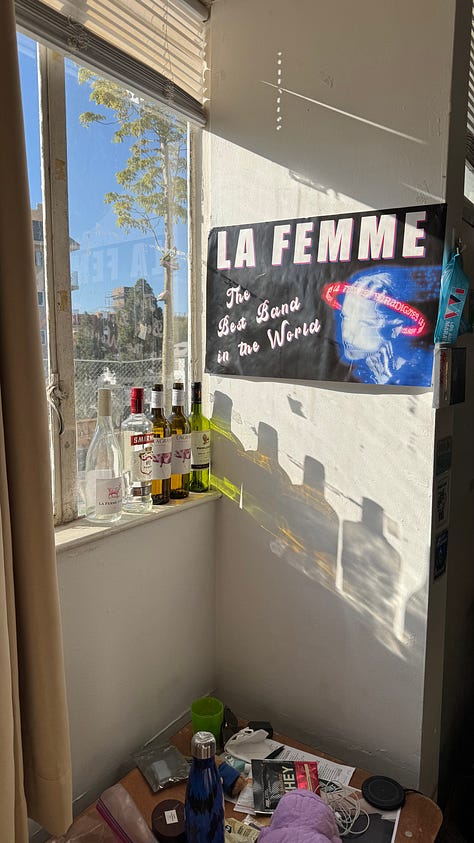

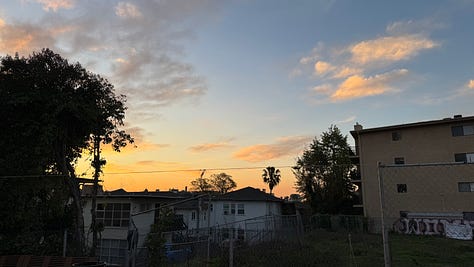
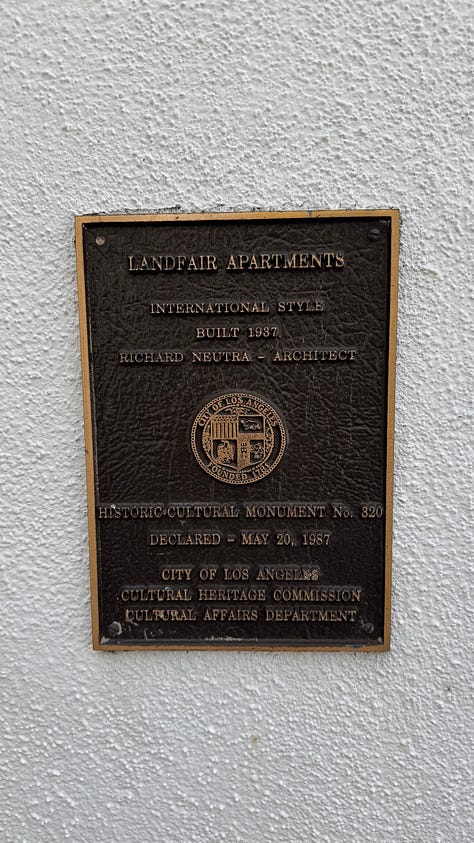
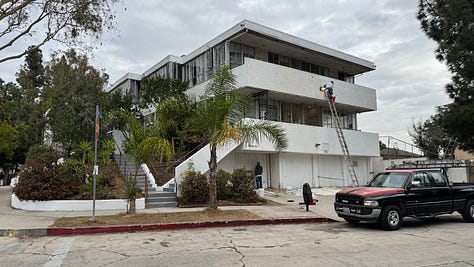

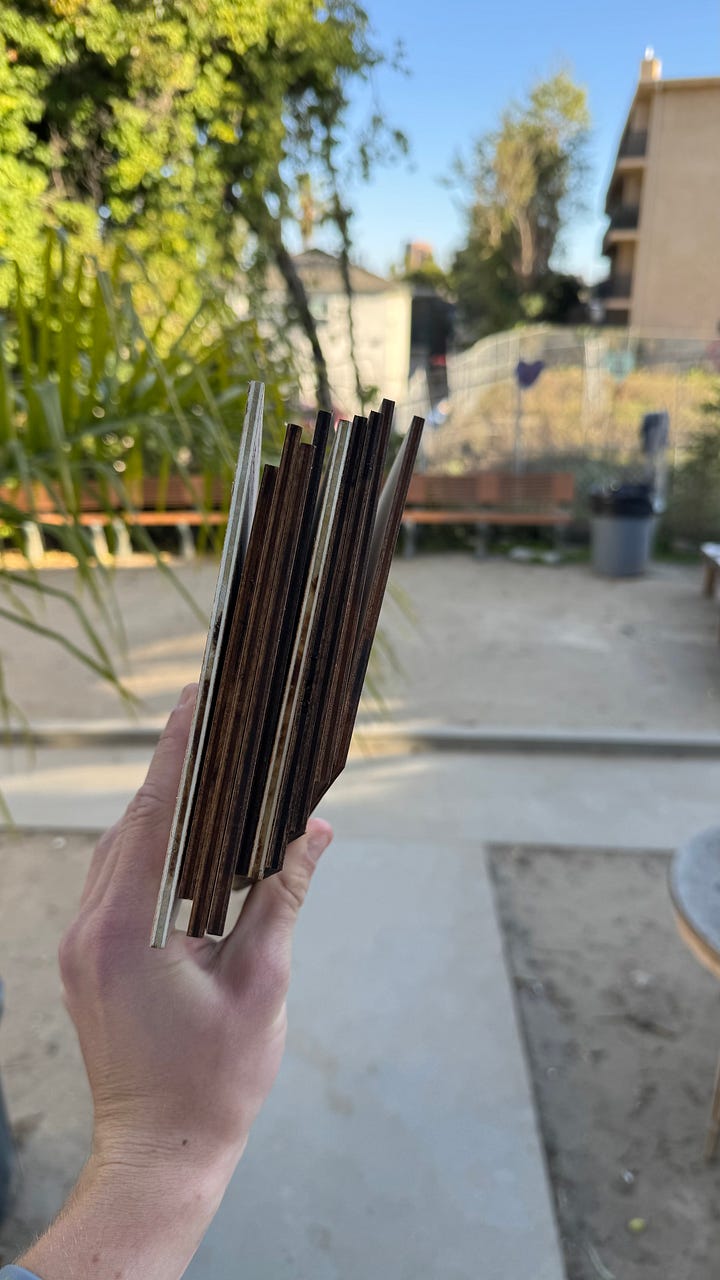
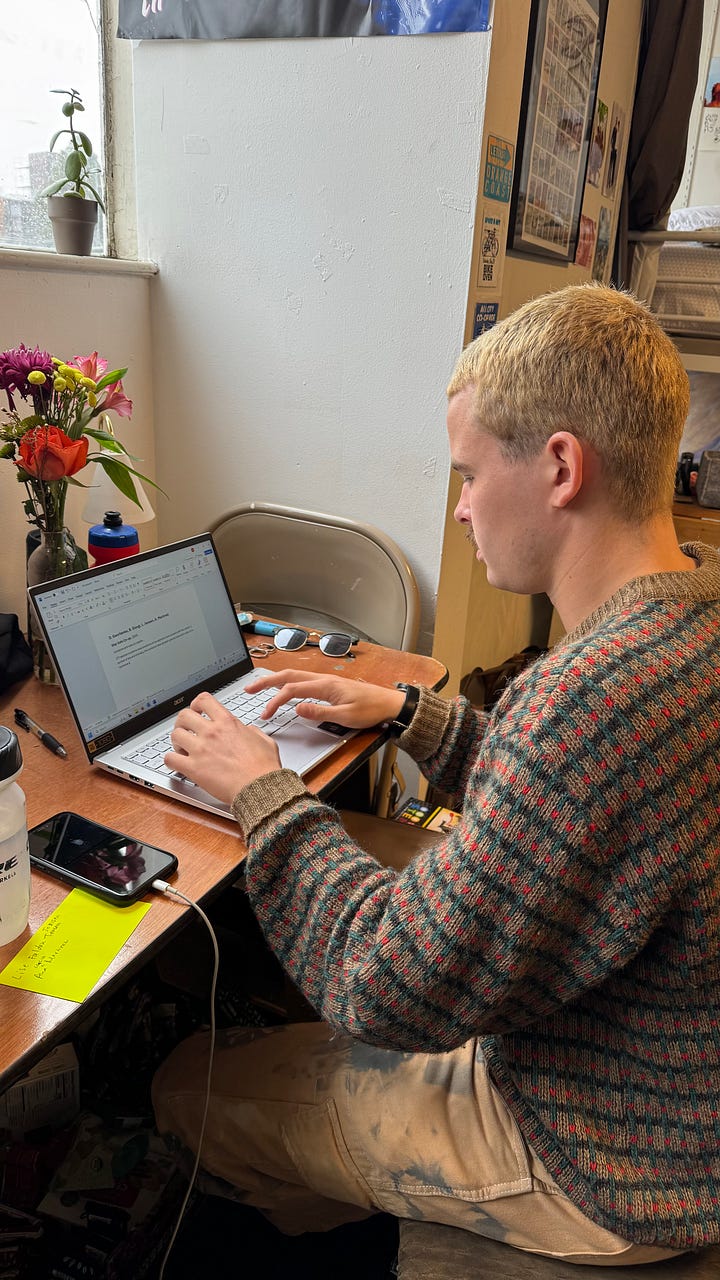
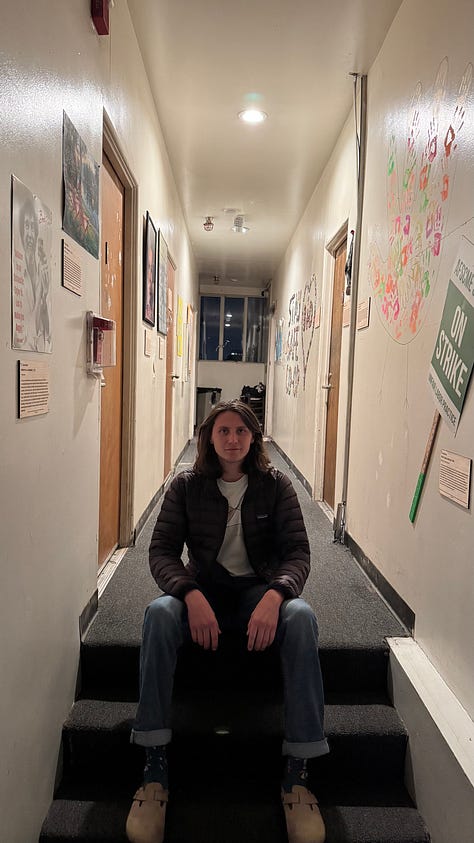

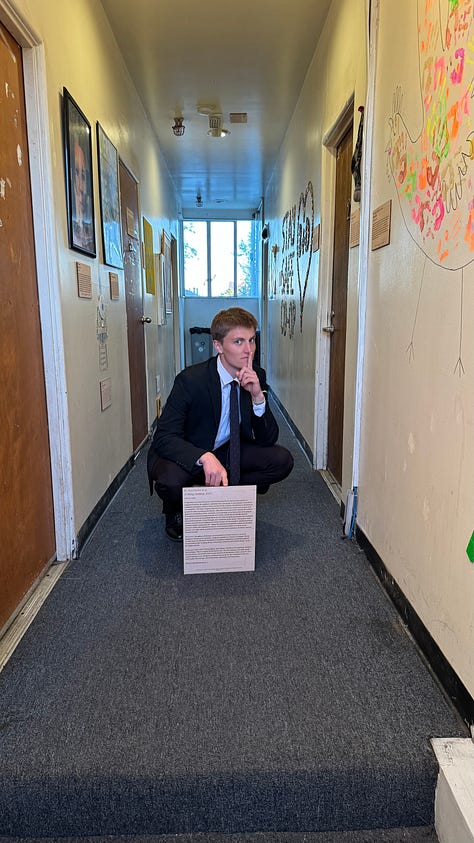
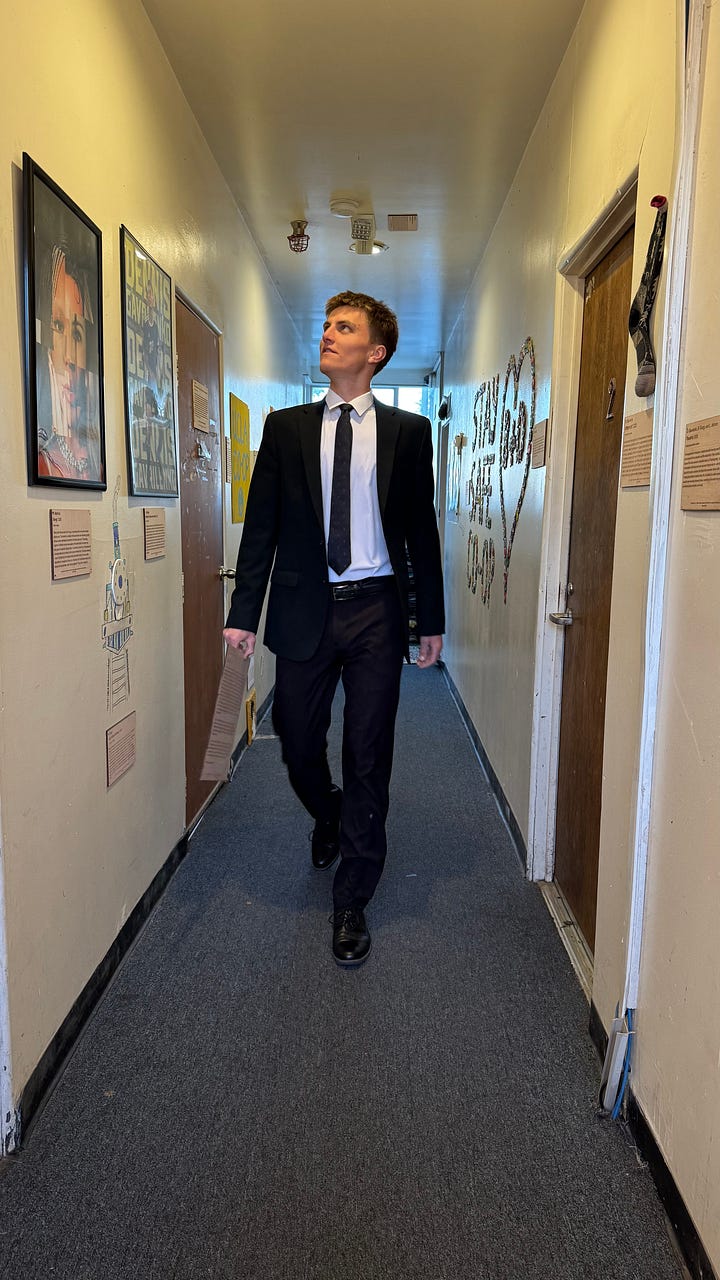
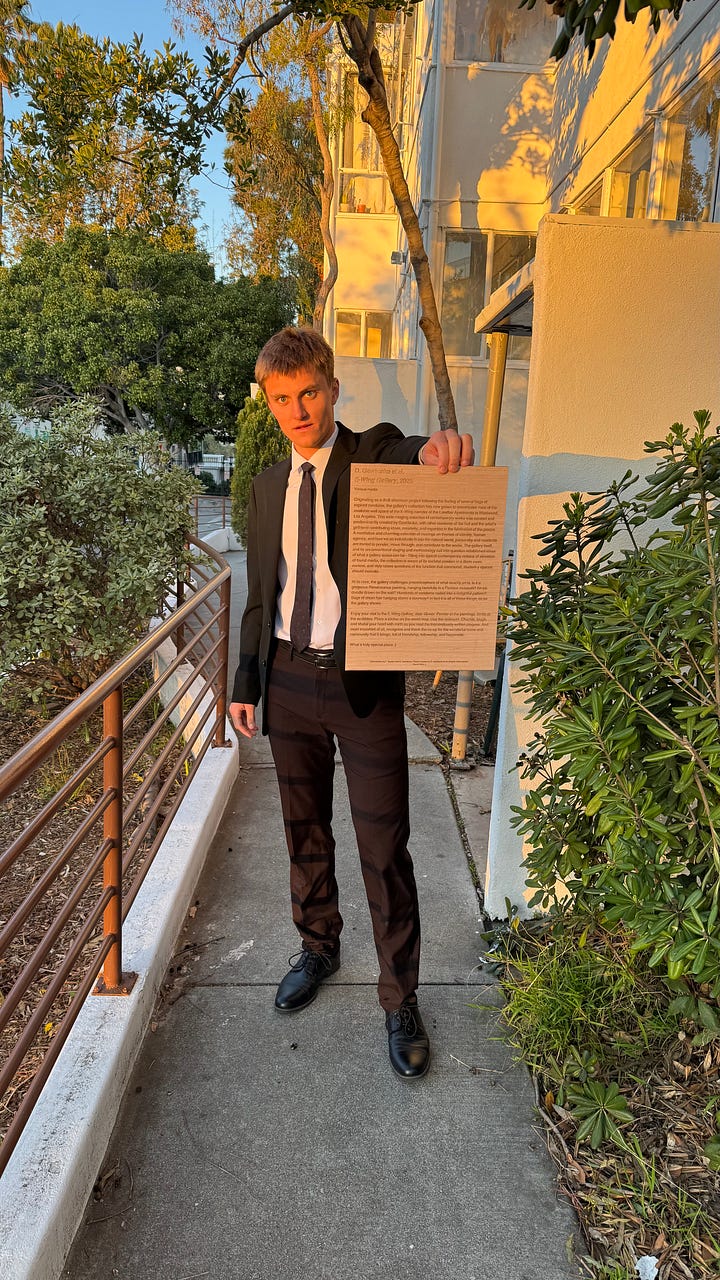
Plaque designs:



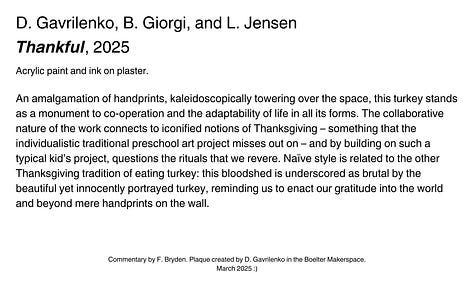

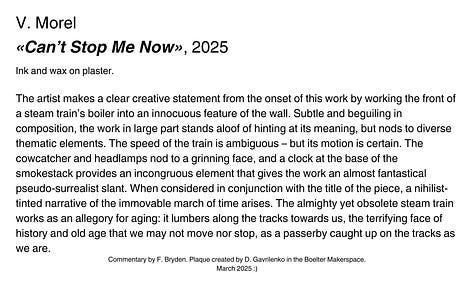



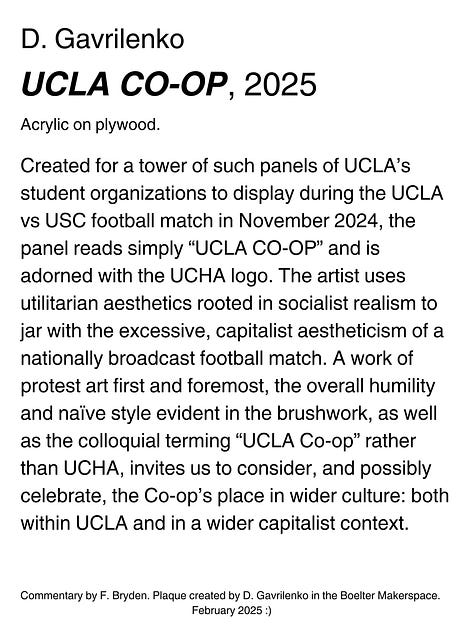








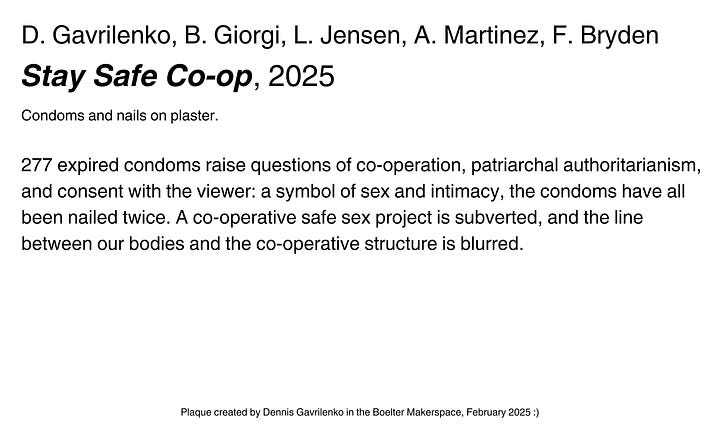

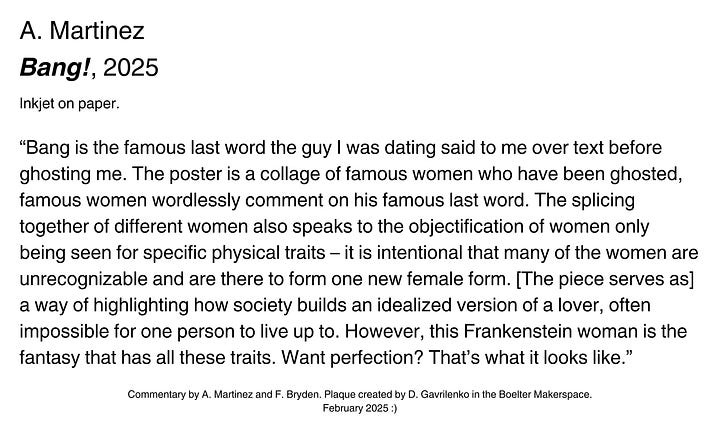
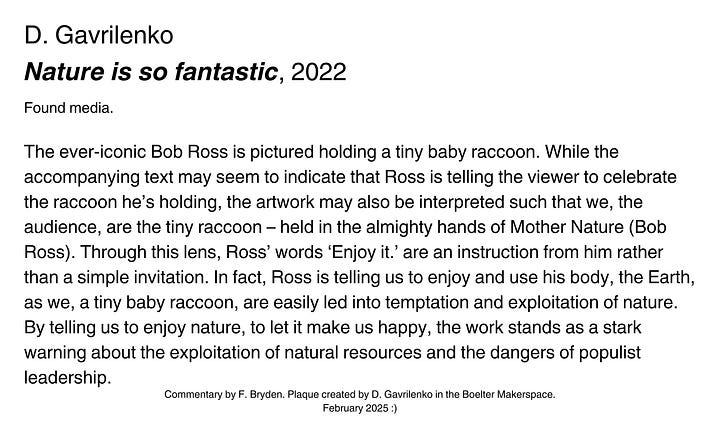
The entire flea story is way funnier when my dad tells it in Russian
As a kid, my mom would take my sister and me to museums across San Francisco; while studying abroad, I made the most of my university ID card and visited dozens of Parisian museums, for free. Plus, I can draw a pretty mean stick figure.
Robison Hall is made up of 7 different wings, denoted A through G. A-Wing has a lovely study lounge with a piano and bean bag chairs, G-Wing has tons of delightfully arranged stolen street signs, and F-Wing has the aforementioned LSD-inspired murals. B-Wing, C-Wing, and D-Wing are cultural wastelands with nothing of note.
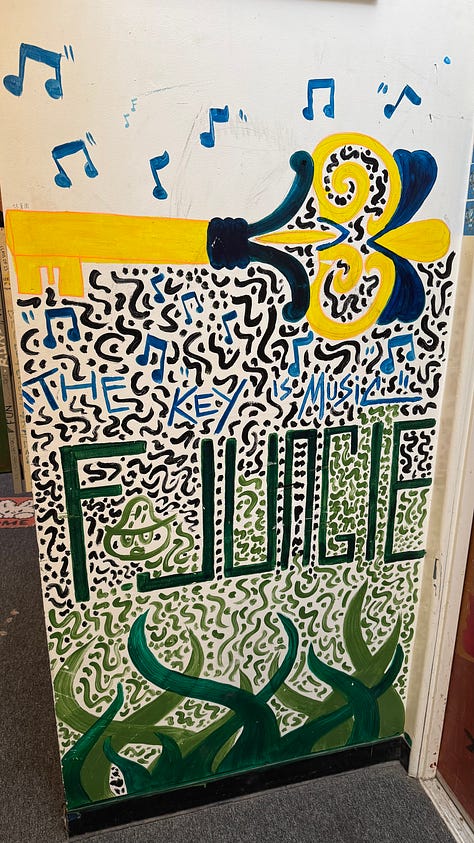
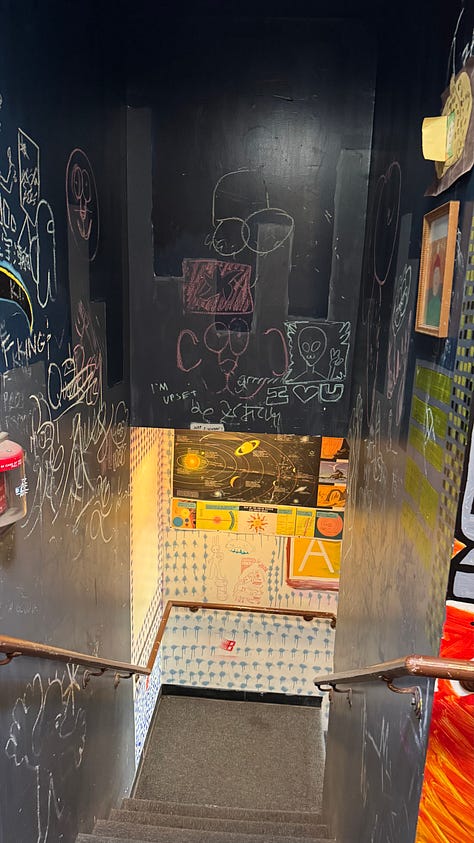
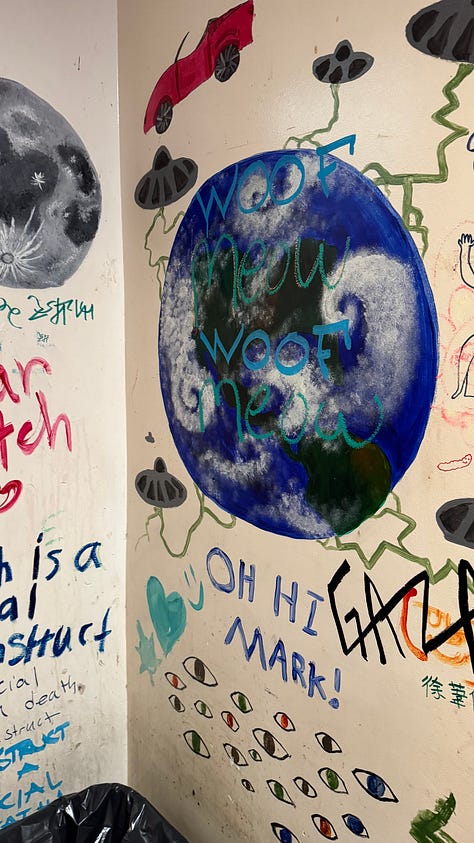
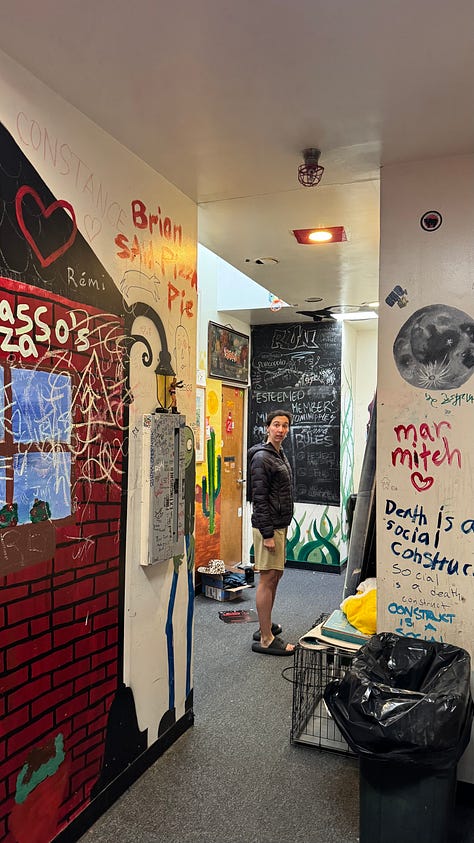
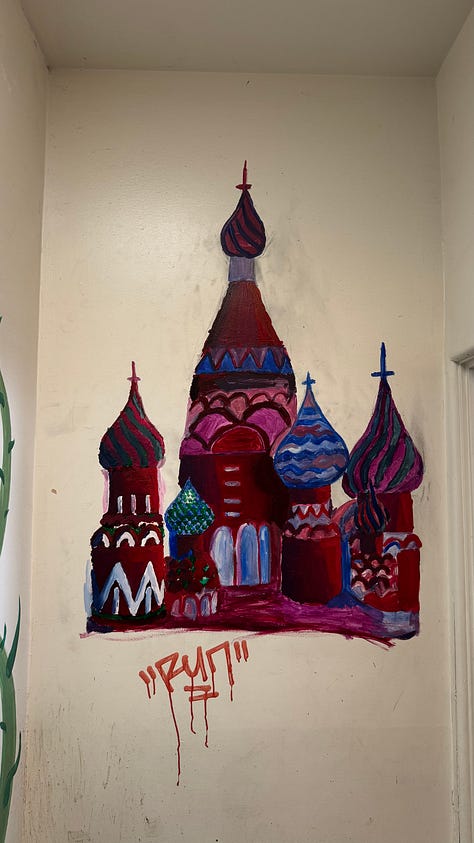
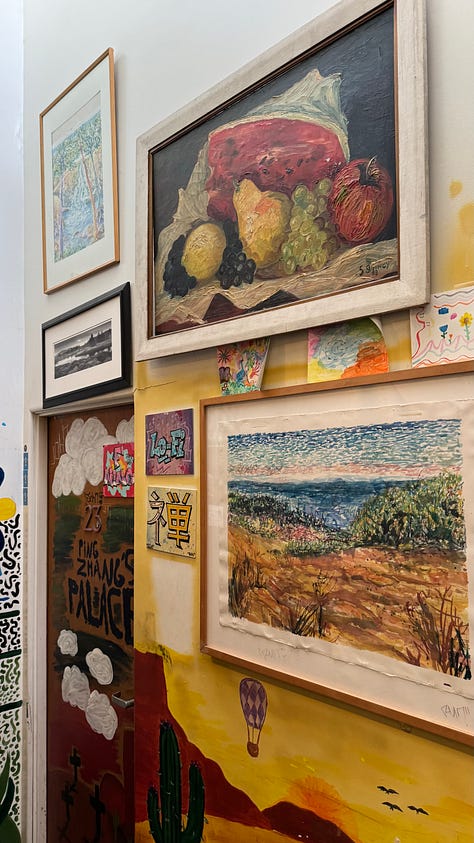
It’s a long story
This mostly entailed learning how to format the various information about the artwork on a flat rectangular plane, including the art name, date, artist, material, etc.
A crash course into the Boelter Makerspace is its own entire beast, but for the purposes of this blog post, I’ll just share how to laser-cut birchwood plaques. I was eventually able to do all these steps super quickly, but the Makerspace student volunteers are super helpful and will help you do all of this if you ask
Create your plaque design in Canva Pro. Ideally, there’s only a white background with black letters, but you could use any picture as long as there’s enough contrast between light/dark colors and shading. Edit with Adobe Lightroom as needed. This definitely takes practice, but is well worth it if you’re serious about plaque-making
Download the design as a PNG file in the highest resolution possible
Transfer the downloaded design to a USB stick and import it into the provided laser-cutting computer
Open CorelDRAW on said computer
Click File, then Import, and open your PNG file
Resize the PNG file as needed. My plaques were all 6 x 10 inches, though some of the larger ones were 7 x 10. The gallery description plaque was 12 x 16
Draw a red rectangle around your design and export the whole thing as a print file
Make sure you have a big enough piece of birchwood in the laser-cutter, make sure the cutting thickness is correct, and cut away!





